Introduction
Australia’s long-standing strategic relationship with the United States is transforming in response to the geostrategic change in the Indo-Pacific and a fractious debate in the United States about its role in the world. At the same time, technological change and economic interdependence have reshaped the nature of interstate competition, creating many new vectors of state power. For Australian policymakers and their American partners, creativity and dexterity are in great demand, with the US-Australia alliance growing in scope and deepening in strategic importance.
With a new administration in Washington committed to both the Indo-Pacific and the value of alliances — and 2021 marking the 70th anniversary of the ANZUS Treaty — this volume advances an agenda for the alliance in this critical phase.
This report is a co-production of the United States Studies Centre and the Perth USAsia Centre.
Three key developments are driving swift evolution in Australia’s alliance with the United States — far and away Australia’s most important strategic relationship.
First, strategic competition with an increasingly capable, assertive and authoritarian China is now widely accepted as the single most pressing challenge for the United States and its allies. This change in the US strategic mindset finds no meaningful partisan opposition in Washington and certainly not among relevant officials in the Biden administration.
Second, rapid technological change and deepening economic interdependence have reshaped the nature of interstate competition since the Cold War, the last era of great power rivalry dominating international affairs. Since then, long-standing, conventional vectors of state power have been transformed; examples include the development of stealth, autonomous systems and hypersonics in the domain of conventional military capabilities or the way that technology has transformed intelligence collection and analysis.
Strategic competition with an increasingly capable, assertive and authoritarian China is now widely accepted as the single most pressing challenge for the United States and its allies. This change in the US strategic mindset finds no meaningful partisan opposition in Washington and certainly not among relevant officials in the Biden administration.
International trade and cross-border investment flows have always been vehicles for projecting and acquiring national power and influence but now have a level of strategic significance not seen in living memory. Infrastructure, energy, frontier technologies and higher education are just some of the domains where a rapid shift in mindset is underway, with national security and strategic considerations now much more salient or even paramount. As the COVID-19 pandemic vividly highlights, points of national vulnerability and risk — and conversely, resilience and strength — are being discovered or created at a brisk pace. This re-emergence of economic tools of statecraft, or geoeconomics, is demanding creativity and dexterity from policymakers and moments of reckoning for democratic societies and their leaders.
These developments are of profound significance for Australia and its alliance with the United States. Australia occupies the middle longitudes of the globe’s most important geographic strategic arena, the Indo-Pacific. The Australia-US alliance has rapidly taken a regional focus and emphasis unseen since the Vietnam War. Australia is one of many countries that counts China as its largest trading partner, but, and unusually for an economy of its size, it has also maintained a highly concentrated mix of exports and destination markets. Accordingly, Australia has been, is, and will be, on the frontlines of geoeconomic competition. Unsurprisingly, this too is broadening and deepening the alliance agenda.
Third, understanding the domestic US political and policy environment must factor into any assessment of the alliance agenda, of how to advance Australian national interests through the alliance. Despite deep and bitter partisan acrimony in the United States, there is much for Australians to welcome. The unified stance on China’s coercive manoeuvres across party lines and between countries is a critical alignment to tackle this high stakes and pervasive issue.
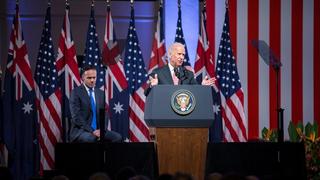
Across the US strategic affairs community, Australia’s credentials as an ally of substance are impeccable. Australia is rightly seen as on the “frontlines” with respect to the China challenge and being willing and able to respond credibly. Across nominees and appointees — their speeches and Senate testimony — and announcements about the tasking and resourcing of agencies, it is clear the Biden administration is prioritising the Indo-Pacific and the role and interests of allies and partners. We survey these developments in the chapters of this volume.
But we also identify a number of challenges to Australian national interests in the US domestic political and policy environment.
- The magnitude of the China challenge is accepted across party lines, but this must be backed by spending commitments and focus to translate aspiration and intent into policy, programs and facts-on-the-ground. (See chapter by Ashley Townshend and Brendan Thomas-Noone)
- Protectionism, isolationism and scepticism about multilateral arrangements are also important legacies of the Trump presidency, supercharged by the COVID-19 pandemic’s damage to the US domestic economy, to the United States’ sense of its priorities and its place in the world. (See chapter by Jeffrey Wilson and chapter by Stephen Kirchner)
- US defence budgets were under enormous strain and scrutiny before COVID-19, opening up a gap between operational capabilities and strategic aspirations in the Indo-Pacific. Countries that felt “out in the cold” in Trump’s Washington are vying for presence and influence with the Biden administration (e.g., NATO partners). Internal competition for resources inside the US Government will also risk distraction from the Indo-Pacific. (See chapter by Brendan Thomas-Noone and chapter by Ashley Townshend and Toby Warden)
- The US and Australian governments are chiefly focused on the immediate health challenges of COVID-19, particularly getting vaccines to their citizens, but there remain opportunities for building more resilient public health systems in the Indo-Pacific. (See chapter by Matilda Steward and chapter by Adam Kamradt-Scott)
- Democratic resilience is no longer a concept solely associated with the developing world. From cyber networks to domestic extremism, the internal focus all democratic governments are undergoing is an opportunity for collaboration. (See chapter by Elliott Brennan and chapter by Jennifer S. Hunt)
- The Biden administration has promised to put climate change considerations at the heart of its thinking about foreign policy and national security. This has prompted considerable speculation about the implications for Australia, with its high carbon emissions per capita and reliance on fossil fuel exports. (See chapter by Simon Jackman and Jared Mondschein)
- Geoeconomic threats to American primacy are prompting the Biden administration to explicitly connect domestic recovery to external strength, with reviews of supply chains and strategic, government-led investments to secure US technological supremacy. But any opportunities — and risks — for allies remain unclear. (See chapter by Hayley Channer, chapter by John Lee and chapter by Jeffrey Wilson)
Accordingly, a clear-eyed understanding of Australian national interests — advancing them and advocating for them in these early months of the Biden administration — is vital, central to the mission of the United States Studies Centre, the Perth USAsia Centre and the purpose of the chapters that follow.
Professor Simon Jackman
Chief Executive Officer
March 2021
US domestic politics and policy
Professor Simon Jackman
For Australian national interests, one issue dominates assessments about US domestic politics. What is the appetite of the United States for a return to global leadership? A range of subsidiary questions follow:
- How quickly, and to what extent, will the Biden administration operationalise the strategic aspirations laid out over the 2020 campaign, for a return to multilateralism, for assembling and leading a coalition of allies and partners in countering China’s assertiveness, for increased presence and power in the Indo-Pacific and for the dollars and focus that this will entail?
- What other policy priorities are competing with these issues and how much salience do they enjoy?
- How robust is the bipartisan consensus around the scale and urgency of the China challenge? Will deep partisan acrimony in the United States impede the Biden administration’s ambitious plans for wide-sweeping competition with China?
To rigorously address these questions the United States Studies Centre (USSC) commissioned surveys of the adult, citizen population of the United States, fielded in October 2020 before the November elections and reinterviewing 1,186 respondents in late January 2021, after Biden’s inauguration. These surveys build on USSC surveys in 2019 and earlier years, utilising much of the same question wording so as to permit valid inferences about trends and change in American public opinion on issues of relevance to Australian national interests.
Trump and the pandemic have hardened American views on China
Figure 1. American opinions about China have hardened, especially among Trump voters
Percentage of respondents agreeing, by president vote. 2019, 2020 and 2021 surveys.
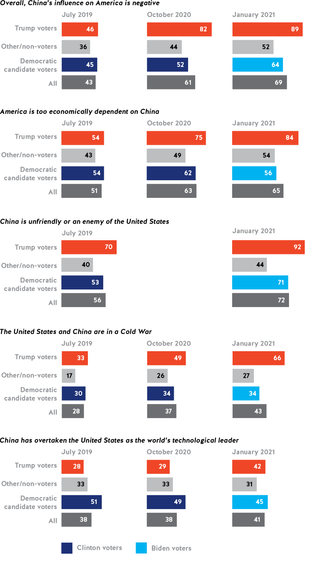
In Figure 1 we summarise responses on five propositions about China and its relationship with the United States, comparing results from USSC surveys administered in July 2019, October 2020 and January 2021. American opinions on China were not especially favourable in 2019 and have generally become more negative since. Trump voters, in particular, have moved even more decisively towards negative views of China after the November 2020 election, no doubt driven by Trump’s insistence about the Chinese origins of COVID-19 and its contribution to Trump losing the election.
- As recently as July 2019, less than a majority of Americans held negative views about China’s relationship with the United States, with little partisan variation. By October 2020 and especially by January 2021, 69 per cent of Americans described China’s influence on America as negative, a view shared by 64 per cent of Biden voters in January and by nine out of 10 Trump voters.
- Seventy-two per cent of Americans describe China as unfriendly towards the United States or an enemy of the United States, up from 56 per cent in 2019 (this item was not asked in October 2020). Trump voters moved 22 points on this measure, from 70 per cent to 92 per cent, and Clinton/Biden voters moved 18 points, from a bare majority (53 per cent) in 2019 to 71 per cent in 2021.
- Forty-three per cent of Americans believe the United States is in a Cold War with China, up from 28 per cent from mid-2019, driven not by change among supporters of Democratic candidates, but largely by a doubling of the rate at which Trump voters report this belief (from one-third in 2019 to two-thirds in 2021).
- In 2019 a slim majority (51 per cent) thought the United States was too economically dependent on China, rising to 65 per cent in our January 2021 survey. The change is almost exclusively driven by a hardening of opinion among Trump voters (54 per cent to 84 per cent), with little movement among Clinton/Biden voters.
- A similar story holds for the proposition “China has overtaken the United States as the world’s technological leader.” There is little movement on this item aside from Trump voters, moving from 28 per cent agreement in 2019 to 42 per cent in January 2021.
The elite, Washington consensus on China is largely mirrored in mass opinion, save for the recent and pronounced hardening of views among Trump supporters. Only slim or near-majorities of Biden voters agree that “America is too economically dependent on China” or that “China has overtaken the United States as the world’s technological leader.” But these proportions are sufficiently large — and the issues sufficiently serious — to serve as a reservoir of political capital for the Biden administration’s policy of competition with China.
The risks of isolationism
For decades researchers have measured isolationism in US public opinion with the proposition “America would be better off if we just stayed home and did not concern ourselves with problems in other parts of the world.” Across our three surveys we see an increase in isolationist views in US public opinion, but again with a distinctly partisan character.
Figure 2. Isolationism has increased dramatically among Trump voters
Percentage of respondents agreeing, by president vote. 2019, 2020 and 2021 surveys.
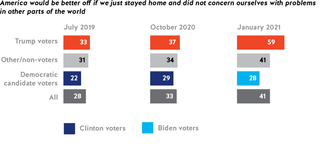
In mid-2019 we observed that one-third of Trump voters expressed isolationist views, comfortably ahead of the 22 per cent rate among Clinton voters. By October 2020, all groups reported an increase in isolationism: 29 per cent among Biden voters and 37 per cent among Trump voters.
The outcome of the November 2020 election appears to have prompted a massive uptick in isolationism among Trump voters to 59 per cent, no doubt a reaction to Biden’s early actions in reversing some key Trump policies, rejoining the Paris Climate Accord (Paris Agreement) and the World Health Organization (WHO), and promising to restore more conventional relations with American allies and partners. Non-voters and supporters of minor parties and independents also moved towards isolationism between October 2020 and January 2021. Biden voters’ levels of isolationism are unmoved through the election period, further suggestive of the political character of the reaction among Trump voters and non-voters.
One of the defining characteristics of “Make American Great Again,” “America First” and, more broadly, “Trumpism,” is hostility to American engagement in multilateralism, catalysing a resentment to globalisation and internationalism evident since the 1990s, ending the elite-led, bipartisan consensus around the virtues of US global leadership. This hostility clearly endures among Trump voters, and indeed, at levels seldom seen in decades of measuring isolationism. This will be a fault line both between the Biden administration and its Republican opponents, but also, critically, within the Republican Party.
It is widely accepted that Trump-led hostility towards multilateralism, and other isolationist elements of the Trumpian worldview, impeded the effectiveness of the Trump administration’s China policy. Accordingly, a key issue for Australia is whether deeper US engagement and presence in the Indo-Pacific can steer clear of opposition founded in isolationism and instead, more helpfully, be motivated by widely-shared, negative assessments of China’s ambitions and assertiveness.
Competing American foreign policy priorities
Survey respondents were asked to rate the importance of three foreign policy priorities, “working with allies to stand up to China,” “dealing with global climate change” and “promoting democracy in other nations.”
There is little partisan disagreement about the importance of “working with allies to stand up to China.” Overall, 85 per cent of respondents saw this as a “very” or “fairly” important priority, with 93 per cent of Trump voters and 88 per cent of Biden voters making this assessment.
But a stark partisan difference emerges on climate change. Almost all (97 per cent) of Biden voters rating this as very or fairly important, compared with just 30 per cent of Trump voters. Biden voters are also more likely than Trump voters to endorse democracy promotion as a very or fairly important foreign policy goal, 78 per cent to 61 per cent.
Figure 3. China is rated as important by majorities of Democrats and Republicans, but climate change is even more important for Democrats
Percentage of respondents rating foreign policy priority as “very” or “fairly” important, by 2020 presidential vote. January 2021 survey.
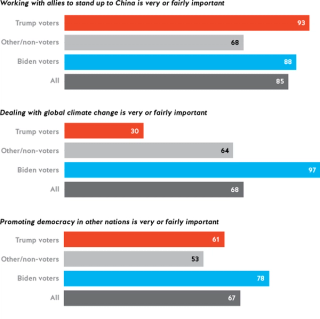
A closer analysis finds that while many Biden voters rate “working with allies to stand up to China” as important, it is almost always subordinate or equal to climate change as a priority. Ninety-three per cent of Biden voters have climate change as their top or equal top foreign policy priority, one-third rate climate change as their single, top foreign policy priority and 28 per cent rate all three priorities as equally important. Only three per cent of Biden voters state that “working with allies to stand up to China” is unambiguously their top foreign policy priority and 13 per cent rank this priority last, behind climate change and democracy promotion.
Table 1. Rank orderings of foreign policy priorities, by 2020 presidential vote
The rank in importance of working with allies to stand up to China, dealing with global climate change and promoting democracy in other nations
|
Importance ranking |
All |
Biden voters |
Trump voters |
Other/non-voters |
|
All equally important issues |
22.8 |
27.7 |
11.2 |
29.5 |
|
Climate most or equal most important issue |
40.9 |
65.0 |
8.0 |
39.6 |
|
China most or equal most important issue |
46.9 |
26.2 |
82.6 |
37.6 |
|
Democracy most or equal most important issue |
18.2 |
13.3 |
23.7 |
19.6 |
|
Climate change least important issue |
20.2 |
2.3 |
50.5 |
12.7 |
|
China least important issue |
8.8 |
12.9 |
0.5 |
12.1 |
|
Democracy least important issue |
20.9 |
29.6 |
11.2 |
17.1 |
For Trump voters, the situation is starkly different, with 57 per cent stating that “working with allies to stand up to China” is unambiguously their top foreign policy priority and just two per cent identifying climate change as their single most important foreign policy priority. Fifty-one per cent of Trump voters rank climate change unambiguously as their least important priority out of the three.
Survey respondents were also asked if the United States ought to “reward countries who do more to stop climate change with more favourable trade deals and impose costs on those that do not” (see Figure 8). Seventy-two per cent of Biden voters agree with this proposition (32 per cent expressing strong agreement) and another 24 per cent are indifferent. Further analysis of the implications of this particular finding appears in a later chapter.
The message for Australian policymakers from this data is clear. The Biden administration’s supporters want the campaign promise of a centrality of climate change considerations to be realised, for climate change considerations to not just be central, but arguably the single most important driver of US foreign policy, and preferably, linked to decisions about trade deals. For Biden’s supporters, “working with allies to stand up to China” is, at most, part of an ensemble of foreign policy challenges.
The Biden administration and Congressional Democrats will find it difficult to ignore this level of political demand from their supporters for climate change to infuse US foreign policy.
Bearing the costs of decoupling from China?
A majority of Americans report that the United States is too economically dependent on China. But are Americans willing to bear the costs that might accompany economic and technological decoupling from China?
We asked respondents if they would prefer to purchase a cell (mobile) phone made in China or a cell (mobile) phone not made in China, while randomly varying the (hypothetical) extra cost of the phone not made in China “in order to reduce our reliance on Chinese made products” (each respondent was randomly assigned to one of the five price points shown in Figure 4.
The Biden administration and Congressional Democrats will find it difficult to ignore this level of political demand from their supporters for climate change to infuse US foreign policy.
In the baseline condition of no price premium for buying “not made in China,” overwhelming majorities report a preference for buying not made in China: 88 per cent overall, every Trump voter and 84 per cent of Biden voters. Unsurprisingly, increasing costs diminishes preference for the not made in China phone, but even with a premium of $250 or more, at least two-thirds of Americans report a preference for the phone not made in China. Trump voters remain most adamant about preferring the phone not made in China across rising cost differences, with around 90 per cent preferring the phone not made in China despite a $250 or even $500 price premium. Biden voters are the most responsive to the increasing price premiums, but even at the $250 and $500 levels, a majority of Biden voters continue to prefer the phone not made in China.
We concede the “cheap talk” nature of assessing willingness-to-pay in surveys. Even so, we note: (1) preferences for the phone not made in China are high, under any circumstances; (2) a partisan gap is nonetheless apparent but grows larger as the price premium of the phone not made in China increases, suggesting that Biden supporters are most exposed to the costs of technological and economic decoupling from China.
These results do suggest partisan fault lines and limits to US domestic political support for decoupling. This said, while it is a Democratic administration pursuing decoupling, rank and file Democrats are likely to follow the cues of their party’s leaders, tolerating any economic burdens stemming from decoupling, especially if these are offset by other elements of the Biden administration’s “build back better” program. Moreover, Republicans are unlikely to use the economic costs of decoupling from China as a credible line of political attack against Democrats, with Republican members of Congress among the most insistent advocates of decoupling.
Accordingly, we assess high levels of economic and political tolerance for decoupling from China in American public opinion and see little incentive for political leaders in either party to mount opposing arguments.
Figure 4. Americans say they are willing to accept the higher costs of buying “not made in China”
Bars indicate the percentages of respondents saying they would prefer to purchase a cell (mobile) phone not made in China (versus a phone made in China), given different levels of increased cost. January 2021 survey.
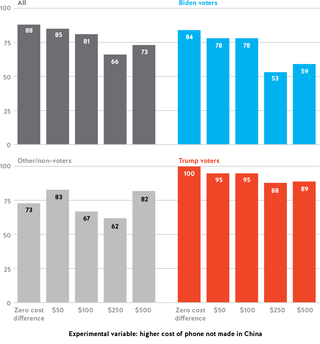
Disunity and American democracy
We conclude this introductory survey of the state of US public opinion and politics, and its implications for the alliance agenda, with an assessment of the depth of partisan animus in the United States. Being positively disposed to one’s fellow partisans is to be expected, almost a defining characteristic of identifying as a Democrat or a Republican. But a relatively novel development in American public opinion is “negative partisanship,” reporting negative evaluations of supporters of the party one does not identify with.
We assess two measures of negative partisanship in the United States, using comparable Australian data to put the results in some perspective for an Australian audience.
Through this chapter, and throughout this volume, we identify instances where this partisanship constrains or impedes policymaking — and equally, note those rare instances of bipartisanship — andtheir implications for Australian national interests.
First, we ask respondents if they would be “happy, unhappy, or if it wouldn’t matter” if an immediate family member said they intended to marry someone who is: (a) a Democrat; (b) a Republican; (c) transgendered; (d) a “born again” Christian.
Forty-four per cent of Trump voters would be unhappy if a family member married a Democrat. In contrast, 52 per cent of Biden voters would be unhappy if their family member married a Republican. For Biden voters, this rate of unhappiness at the prospect of a family member marrying a Republican (52 per cent) exceeds the unhappiness rate reported if family members were to marry a transgendered person (19 per cent) or a “born again” Christian (39 per cent).
Corresponding Australian data help put these results in context. Just 17 per cent of Coalition voters say they would be unhappy if an immediate family member intended to marry a Labor supporter; conversely, 28 per cent of Labor supporters and 32 per cent of Greens supporters say they would be unhappy if an immediate family member intended to marry a Coalition supporter. These Australian rates of unhappiness at the prospect of partisan inter-marriage are at most half of the corresponding rates we observe in the US data.
Second, survey respondents are asked to provide “thermometer ratings” of partisan groups, on a zero-to-100-point scale.1 Median ratings of major parties are reported in Table 2, broken down by who the respondent voted for in the most recent national election.
Table 2. Negative partisanship in the United States is far more pronounced than in Australia
Median thermometer ratings of parties, by vote. January 2021 surveys.
|
US data |
Australian data |
||||||
|
2020 vote |
Median rating of Republican Party |
Median rating of Democratic Party |
Party difference |
2019 Vote |
Median rating of Coalition parties |
Median rating of Labor party |
Party difference |
|
Biden |
13 |
80 |
57 |
Labor |
38 |
76 |
38 |
|
Trump |
63 |
5 |
58 |
Coalition |
80 |
46 |
34 |
|
Other/non-voter |
44 |
49 |
5 |
Greens |
22 |
66 |
44 |
|
|
|
|
|
Other/non-voter |
60 |
56 |
4 |
In-party ratings are essentially the same in both countries, around the 80 mark on the zero to 100 cold-to-hot thermometer scale. An exception is the 63 median rating given by Trump voters to the Republican Party, a reaction no doubt to criticism of Trump from Republican leaders after the Capitol Hill insurrection on 6 January 2021, Trump’s subsequent impeachment and Trump’s hostility towards Republican election officials in Georgia inter alia during the post-election period.
The key difference between the United States and Australia are the ratings of out-parties. The median rating of the Democratic Party from Trump voters is just five; the Republican Party gets a median rating of 13 from Biden voters. In Australia, the median out-party ratings are markedly higher: Labor voters give a median rating of 38 to the Coalition parties, while Coalition voters give a median rating of 46 to the Labor Party (barely below the neutral rating of 50). This constitutes more compelling evidence of the depth of partisan animus in the United States and the contribution of negative partisanship to political polarisation in the United States.
The United States transitions from the Trump to Biden presidencies with partisan polarisation at extraordinarily high levels; Australian audiences can only marvel at this critical feature. Through this chapter, and throughout this volume, we identify instances where this partisanship constrains or impedes policymaking — and equally, note those rare instances of bipartisanship — and their implications for Australian national interests.
The Biden agenda, Congress and Australian interests
Joe Biden proposed an expansive legislative agenda throughout the 2020 presidential campaign, spanning racial justice and voting rights, green energy jobs programs, buttressing Obamacare and infrastructure. But sitting above all these issues is control of the pandemic and rebuilding the US economy.
President Biden simply must get his US$1.9 trillion COVID recovery package through Congress (and may well have by the time this volume is published). There is a deep understanding — which Republicans recognise as much as Democrats — that if Biden fails on this first hurdle, his presidency will be permanently damaged. In fact, failure to win congressional approval on the American Recovery Plan will mean that Biden will be unable to win congressional approval of virtually all the other priority measures listed above that he took to the election.
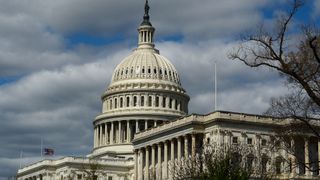
The key to understanding what Biden can accomplish in Congress requires an appreciation of the political dynamics that affected and ultimately overcame, Obama’s presidency. Indeed, the lessons from the 111th Congress — the first two years of President Obama’s first term — are the guideposts for Biden’s strategy and approach in this 117th Congress.2
Like Presidents Bill Clinton and Barack Obama, Biden comes to office as a Democratic president with his party in the majority in both houses of Congress. Biden also has an agenda with marked similarities to Obama’s: rebuilding an economy struck down by crisis, addressing an urgent health care reform agenda, securing progress in the epic battle to combat global warming and a host of other compelling social priorities.
Figure 5. Democrats control Congress, but with razor-thin margins
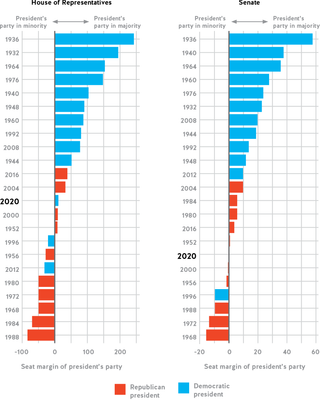
But unlike Clinton and Obama, Democratic control of Congress is tenuous — just six seats in the House of Representatives and Vice President Harris the tiebreaking vote in the Senate — and at great risk in the 2022 midterms (see Figure 5). Midterm elections typically see the party of the president lose seats. As shown in Figure 6, the midterms of 1994 and 2010 resulted in huge gains for Republicans in House elections, ending unified Democrat control of the federal government and stalling the agendas of both Clinton and Obama. With dogged opposition to the last two Democratic presidents successful in those midterm elections, Congressional Republicans have little incentive to support Biden’s policy proposals. The Capitol Hill insurrection on 6 January 2021 further dampened the already remote prospects of bipartisanship.
Figure 6. Midterm elections typically see the party of the president lose House seats
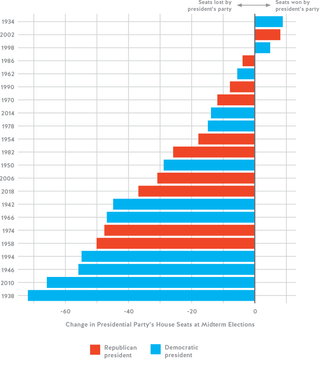
Biden’s calculus is that if he fails to secure passage of the American Recovery Plan or meet his ambitious vaccination targets (100 million shots in the first 100 days) his presidency is lost too, along with any chance of legislative success on racial justice, climate change and immigration.
As Vice-President, Biden was central to the Obama administration’s protracted and ultimately self-defeating negotiations with Congressional Republicans in 2009 and 2010. Democrats were unsatisfied with the policy compromises that resulted (on recession recovery, on health care, on climate) and lost the House of Representatives: policy pain and no political gain. Biden has no intention of being guilty of repeating that mistake.
This is why Biden is determined to go big and go early, to get the vaccine and economic stimulus in place as soon as possible, and without Republican votes, if needs be.
The House of Representatives
In the 117th Congress that convened in January 2021, the House is comprised of 221 Democrats and 211 Republicans. While margins are immensely tighter than Obama and Speaker Nancy Pelosi faced in 2009, the political dynamics are the same: to be successful, Democrats will have to find the balance on complex legislation within the caucus to ensure that defections do not kill President Biden’s agenda — severely undercutting his presidency. Speaker Pelosi and her leadership team have nearly no cushion for error as the threshold between winning or losing comes down to just a couple of Democrats.
This is all the more important given that the House will be the driver of the Biden legislative program. The key lessons of successful legislative management by the Democrats in the 111th Congress are no less applicable to President Biden and Speaker Pelosi today. In particular, look for:
- Clear and consistent leadership from the President on his agenda and legislation. President Biden’s voice must be forceful, consistent and steady in laying out and explaining what he wants Congress to do, giving assurance to members in swing districts.
- Intensely effective working partnerships between the president, the speaker and her committee chairs. Key to Speaker Pelosi’s success throughout her tenure is her exceptional ability to read the moods and dispositions of the members of the Democratic Caucus and to have those assessments guide chairs of the committees in crafting legislation.
- A vigorous schedule of hearings to underscore the urgency of the legislative agenda. In both Obamacare and the energy and climate legislation in 2009, carefully constructed hearings showed the high degree of consensus of key interests and constituencies behind these major legislative reforms. The health insurance and pharmaceutical industries strongly supported the Affordable Care Act. Energy, chemical and manufacturing companies supported the cap-and-trade bill. These very visible shows of consensus paved the way to advance these landmark proposals.
The Senate
The 50-50 tie in the Senate plus the tie-breaking vote of Kamala Harris gives the Democrats control of the Senate’s agenda, its calendar, committees and critically, which bills come up for votes on the Senate floor.
The biggest initial dividend of control of the Senate for President Biden is that the Democratic majority will generally approve his Cabinet nominees. The withdrawal of Nerra Tanden’s nomination as director of the Office of Management and Budget is the first real hiccough, highlighting the immense power of “red state” Democratic Senators looking to distinguish themselves from their Democratic colleagues (e.g., Manchin from West Virginia).
Even if the House leadership can find agreement among all House Democrats on these contentious issues among all the factions in the party, the lion’s share of the Biden legislative agenda is dead on arrival in the Senate.
Key elements of Biden’s agenda will be subject to the Senate’s supermajority requirement: 60 Senators are necessary to call debate to a close (to end a “filibuster”) and move legislation to a majority vote on final passage. Budget legislation is exempted from the filibuster’s supermajority requirement. Both political parties have at times relied on packaging major policy programs into the reconciliation process like the 2001 Bush Tax Cuts, Obama’s 2010 Affordable Care Act and, most recently, the 2017 Tax Cuts and Jobs Act. Biden’s COVID recovery legislation will be considered this way, circumventing compromises with any Republican senators, but underscoring the importance of holding Democratic senators together. This will test Majority Leader Schumer’s political and parliamentary skill, in particular, (a) dealing with the extraordinary negotiating power of “red state” Democratic Senators (who can credibly threaten to vote against the legislation and hence can extract concessions and amendments) and (b) using parliamentary procedures that keep the comprehensive COVID recovery package more or less intact, bringing an up-or-down vote that is much more costly for rebel Democrats to vote against.
Any realistic assessment of the current configuration of Congress must recognise: (a) that there are not 10 Republican votes in the Senate willing to support virtually any element of the Biden agenda; (b) there are limits to what can be legislated via the budget reconciliation process that circumvents the filibuster; (c) there is dwindling appetite for attacking the filibuster itself by enacting changes to Senate rules or for overruling the Senate parliamentarian’s determinations about what can be legislated via reconciliation; and (d) even for majority votes on the Senate floor, all 50 Democrats must vote together, or have defections offset by Republicans crossing the aisle.
Accordingly, even if the House leadership can find agreement among all House Democrats on these contentious issues among all the factions in the party — from the progressives on the left led by Representative Alexandria Ocasio-Cortez to the moderates who won Trump districts in the suburbs in 2018 and held them in 2020 — the lion’s share of the Biden legislative agenda is dead on arrival in the Senate.

Exceptions that prove the rule
There will, however, be several key exceptions of great relevance for Australia:
Defence spending. In early January 2021, in the closing days of the 116th Congress, both the House and Senate overrode President Trump’s veto of the National Defense Authorization Act, which sets military spending levels and locks in US strategic priorities for the country’s defence posture.3 This was the first time Congress had overridden a Trump veto. This spirit of bipartisan cooperation on defence will carry through the Biden presidency, with most Democrats joining most Republicans to ensure steady commitment to overall US defence policy, spending levels and weapons programs. Defence spending will be a major ongoing target of Democrats on the left in both the House and Senate, but on these issues, the centre will prevail.
Foreign Policy. President Biden has entered office without the United States engaged in major wars overseas. Biden’s much firmer stance on Russia and President Putin, the aim of restoring effective working relationships with America’s allies in Europe and Asia, and Biden’s tougher position on human rights, from Saudi Arabia to Burma to China, will be strongly welcomed. The House and Senate foreign relations committees will be active on legislation that will provide incentives and punishment on human rights issues.
Appropriations and government funding. An enduring trend, even under the Trump presidency, was the ability of the House and Senate to work through the government spending (supply) bills for all the government agencies and their operations. The Appropriations Committees have been able in recent years to reach agreements to keep the government operating. The longest government shutdown in American history, however, occurred under President Trump, who insisted, as a condition of signing legislation to maintain orderly funding of the government, that Congress approve funding for the border wall with Mexico.4 Trump ultimately backed down on his demand and normal operations resumed. This was such a searing political experience that, with a president such as Biden — a creature of Congress — a repeat of that confrontation is highly unlikely.
Congress and Australian interests
There are several major issues directly affecting Australian interests:
China. Leaders in Congress on China policy are highly aware of Australia’s frontline status with respect to China and Australia’s alliance credentials. As in the Trump administration, this bipartisan coalition will serve a valuable role in helping ensure executive branch policy and actions are mindful of Australia’s interests.
Trade. Leaders in Congress on trade will be sympathetic to Australia’s long-standing fidelity to free trade norms and policies and will pay special attention to China’s economic coercion of Australia. There is little evidence of Congressional support of the United States joining the CP-TPP, at least not until the US economy has meaningfully recovered from COVID.
Military posture. As discussed above on the defence spending issues, Congress will welcome continued further deepening and coordination on the military alliance and overall posture in the Asia Pacific, especially with respect to China and its projection of sovereignty and force.
Big Tech. Australia’s strong stance against the market abuses of big tech companies, especially Facebook and Google, has captured the attention of both members of Congress who follow these issues closely and the administration officials and agencies who oversee antitrust and consumer protection issues.5 Conversely, there is little love for Big Tech in Congress nor any chance of Congress being sympathetic to any claims that social media giants have been treated unfairly by Australia.
Climate change — a special case. Climate change and global warming have already proven to be an issue that is directly affecting Australian politics. Biden’s commitment to move aggressively on climate is a pillar of his overall agenda. His stance on climate was crucial to winning the support of Senators Bernie Sanders and Elizabeth Warren for the Democratic nomination. In office, Biden has affirmed reaching stringent carbon-reducing targets by 2050, and has moved aggressively6 through executive orders to reverse Trump policies that rolled back environmental regulations, ended carbon-intensive projects such as the Keystone XL pipeline and permit approvals that would have opened public lands and off-shore tracts to oil and gas drilling.
These measures, especially the support for firm 2050 targets, have provoked political debate here on Australia’s climate policy. Carbon pricing — a critical lever in realising emissions targets — is an obvious threshold issue. It is unclear whether the Biden administration would welcome or propose legislation on carbon-pricing, but a sustained debate in the US Congress on carbon-pricing, even if the legislative passage were to fail, would spill over into Australian domestic politics.
In the interim, there is nothing the Australian Government can say or do that will slow down, delay or stop any action Biden and his climate advisors — led by former Secretary of State John Kerry, who is fully seized of the climate issue — take to address climate change.
In a later chapter we revisit this issue, assessing that while any material divergence in climate policy between the two countries will be an irritant, such differences will not in any way threaten the deep fundamental relationship between the two countries.
An engaged America — led by a President not only supportive of the rules-based, international order but with the political capital to drive the supporting policy and action from Congress — is a stronger and more effective alliance partner of Australia.
We further assess that if Biden were to propose carbon-pricing legislation, Congressional enactment is unlikely. In 2009, the Waxman-Markey “cap-and-trade” program passed the House despite the defection of dozens of Democrats from energy-producing states because of the support of a crucial handful of Republicans. The Waxman-Markey Bill was never brought to a vote in the Senate and died. We doubt that in the current Congress carbon-pricing would even make it out of the House of Representatives, let alone make it to the Senate floor.
This suggests that political spillovers into Australia on climate and emissions will intensify only in so far as a Democratic-controlled Congress actively engages on the issue. US policy proposals will also powerfully shape the terms of debate here on what Australian policy should be.7 Conversely, should Biden climate and emissions policy hit a political wall in Washington — with Congress the key actor — the intensity of Australian debate may not necessarily diminish, but the scope of climate policy options will likely be limited along similar lines.
Australian national interests dovetail with Biden being successful in overseeing America’s recovery from the COVID-19 pandemic. A prosperous, capable and self-confident United States is more likely to take on the burdens of global leadership and projecting power and presence into the Indo-Pacific, of bearing the costs of competition with China.
But there are second-order effects at work too, tying Australian national interests to Biden’s domestic political fortunes. American power and prestige abroad are in no small measure functions of the domestic standing of the incumbent president. Early successes for Biden will earn him political capital for pushing back against the voices of protectionism, isolationism and unilateralism in the Congress. An engaged America — led by a President not only supportive of the rules-based, international order but with the political capital to drive the supporting policy and action from Congress — is a stronger and more effective alliance partner of Australia.
Strengthen the global and regional trade architectures
Context and background
Australia needs to facilitate US re-engagement with the rapidly evolving global and regional trade architectures.
During the Trump administration, the United States withdrew from several important trade institutions, while launching a series of costly — and ultimately ineffective — trade wars. These policies have compromised the integrity of global trade institutions and weakened the benefits of regional trade agreements such as the Trans-Pacific Partnership (TPP). While the Biden administration has signalled a change in approach to trade issues, countervailing domestic and international imperatives mean the direction of its trade policy remains unclear. Australia now has an opportunity to shape the trade policy outlook of the Biden administration in a way that favours rule making, multilateralism, and greater collaboration with allies and like-minded partners.

The Biden administration
The Biden administration inherits a ruinous set of trade policies from its predecessor. Trump’s first presidential act was to withdraw from the TPP, greatly weakening an institution that locked in a US-preferred model for trade liberalisation. The Trump administration vetoed new appointments to the World Trade Organization (WTO) Appellate Body, rendering its dispute settlement and rule-enforcement functions ineffective. It aggravated allies and friends by imposing trade balancing agreements under thinly-veiled threats of diplomatic coercion. Most significantly, it prosecuted a self-harming bilateral trade war with China, which has demonstrably failed to either change the US-China trade balance or lever reform to China’s trade practices.
While the Biden administration has signalled an intent to change trade policy, mixed signals mean its new direction remains unclear. On the positive side, it has flagged a more multilateral approach to managing trade tensions with China, recognising that Trump’s bilateral trade war has failed.8 The selection of Katherine Tai — a veteran trade lawyer with deep China expertise — as the next US Trade Representative telegraphs that substantive issues (such as intellectual property) will now dominate the agenda.9 The United States has begun to re-engage with the WTO by supporting the appointment of its next Director-General and may remove the veto on Appellate Body appointments, restoring the global trade dispute settlement mechanism to normal function.10
Table 3. US trade diplomacy under the Trump administration
|
Target |
Year |
Action |
|
Trans-Pacific Partnership partners |
January 2017 |
Withdrawal from Trans-Pacific Partnership, rendering entry-into-force numerically impossible |
|
WTO members |
January 2017 — ongoing |
Systematic veto of Appellate Body nominations to force US-requested governance reforms; Appellate Body became inquorate on 10 December 2019 |
|
Canada and Mexico |
August 2017 — September 2018 |
Renegotiation of North American Free Trade Agreement under threat of termination |
|
Korea |
January — September 2018 |
Renegotiation of Korea-US Free Trade Agreement under threat of termination |
|
World |
March 2018 — ongoing |
Tariffs applied to solar panels, washing machines, steel and aluminium imports on national security grounds; Canada, China, the EU, India, Mexico, Turkey and Russia all impose retaliatory tariffs |
|
China |
July 2018 — ongoing |
Escalating the application of tariffs to demand a bilateral trade agreement, rising to cover $550 billion of imports from China; China repeatedly retaliates, with tariffs imposed on $185 billion of exports from the United States |
|
Turkey |
August 2018 — ongoing |
Removal of Turkey from US Generalised System of Preferences (GSP) scheme; imposition of additional 25 per cent tariff on Turkish steel (enacted August 2018, withdrawn May 2019, reimposed October 2019) |
|
Japan |
April — December 2019 |
Negotiation of a bilateral trade agreement favouring US agricultural exporters under threat of tariff imposition |
|
European Union |
May 2019 — ongoing |
Imposition of retaliatory tariffs on $7.5 billion of EU exports in Airbus dispute; threatened imposition of 25 per cent tariff on automobiles to force a trade-balancing bilateral agreement |
|
India |
June 2019 — ongoing |
Removal of India from the US Generalised System of Preferences (GSP) scheme |
|
Brazil and Argentina |
December 2019 |
Removal of exceptions from steel tariffs in retaliation for alleged currency manipulation |
However, countervailing imperatives mean the Biden administration is also unlikely to fully recommit to trade liberalisation or rule making. Trump’s China tariffs will be politically costly to wind back at home (particularly in the steel sector) and also function as bargaining chips for future negotiations with China. It is unlikely they will be unilaterally reduced in the near term.11 Biden’s “Buy American” pledge12 is not strictly a trade policy but indicates that protectionism will remain a feature of US economic policy. Several selections to the Council of Economic Advisers have a record of trade scepticism, suggesting liberalisation is unlikely to be on the immediate agenda.13 Rejoining the TPP will also be a longer-term proposition, due to opposition within Congress at home and complex negotiations with partners abroad.
Beyond the costs to the US economy itself, trade policy under the Trump administration has been harmful to the global and regional trade architectures. The WTO’s dispute settlement mechanism has been compromised due to Appellate Body appointment vetoes and cannot enforce trade rules in a timely and effective manner.14 The United States has disengaged from regional trade diplomacy, depriving these efforts of the political and economic heft that US leadership offers. Bilateral pressure on China has failed to achieve Trump’s objective of increasing US exports,15 and even then, a focus on trade balancing ignores the real trade policy challenges currently posed by China, such as intellectual property protection and subsidies to state-owned enterprises.
Australian interests
The absence of US trade leadership is a major challenge for Australia. As a highly open economy, Australia depends on a reliable and rules-based trade system. Its medium size means Australia lacks either the economic or political heft to defend its trade interests bilaterally, so multilateral institutions, such as the WTO globally and the TPP regionally, are of critical importance. US disengagement — and at times, non-constructive interventions — threaten the reliability of these institutions. It also deprives Australia of a powerful and like-minded partner to work within new trade negotiations.
US re-engagement with global and regional trade architectures is critical for Australia’s national interests. However, the extent of current US disengagement, and competing domestic and international imperatives, means the direction and pace of trade policy recalibration under the Biden administration cannot be taken for granted. Australia should engage the United States to encourage and shape patterns of re-engagement in 2021 and beyond.
Policy recommendations
- Communicate the importance of a functioning WTO system and collaborate on WTO reform efforts. Australia should clearly reiterate to its alliance partner the value of a rules-based and functional global trading system. It should also work with the United States to support constructive WTO reform efforts, particularly in terms of the smooth functioning of the dispute settlement mechanism.
- Begin preparatory work enabling the United States accession to the Trans-Pacific Partnership. Domestic economic priorities in the United States mean its accession to the TPP will be a long-term process. However, preparatory efforts should begin now to address key obstacles. Within the TPP group, Australia should lead discussions on how the (presently untested) accession mechanism will operate. With other major TPP economies — such as Japan, Canada and Singapore — it should start engaging the United States on key reform issues that need to be negotiated. Of key importance are issues to do with the implementation of intellectual property provisions suspended as a result of the United States’ departure from the regional agreement in 2017.
- Support confidence-building through US-Australian leadership in emerging trade platforms. Constructive US engagement in new multilateral trade platforms will help restore global confidence in the United States as a trade policy leader. Australia and the United States could work together in areas of shared priority. A useful starting point is the recently-launched e-commerce negotiations within the WTO, which Australia co-convenes with Japan and Singapore.16 Establishing global e-commerce rules will be essential in protecting the 21st-century industries of these economies and would also signal to the world a more engaged and leadership-oriented US trade outlook.
Enhance health cooperation in Southeast Asia and the Pacific
Matilda Steward
Context and background
Australia and the United States should build on existing commitments to strengthen health security in Southeast Asia and the Pacific. These efforts must focus on addressing the secondary impacts of the COVID-19 pandemic, which threaten to reverse fragile gains made across broader health and development indicators over recent decades. Despite early containment measures resulting in lower caseloads throughout Southeast Asia and the Pacific compared to other regions, progress in controlling the spread of the virus and the ongoing capacity of national governments to respond to outbreaks remains deeply uneven.17 Diversion of material and human resources to address COVID-19 has placed further strain on already weak health systems, causing significant disruption to essential services and stalling momentum towards universal health coverage.18 An estimated 34.8 million infants throughout Southeast Asia have missed routine vaccinations as a result of the pandemic,19 with health experts warning that efforts to control and eradicate malaria in the Pacific are also at risk.20
The 2020 AUSMIN Global Health Security Statement established a foundation for bilateral cooperation in tackling COVID-19 throughout the region with its pledge to strengthen and accelerate health security capacity building.21 Australia and the Biden administration should recommit to this joint plan of activities with an expanded remit to confront a broader suite of health and development challenges emerging from the pandemic. This approach will be crucial for ensuring collective action strengthens health systems holistically, rather than creating parallel infrastructure that operates solely in response to COVID-19 and generates limited long-term impact.22

The Biden administration
Engagement with multilateral institutions and stronger coordination with allies in meeting global health challenges is a key priority for the new administration. President Biden has stressed the need to “restore US global leadership to fight [the COVID-19] pandemic” and reversed former President Trump’s withdrawal from the World Health Organization on his first day in office.23 The White House roadmap for combating coronavirus includes ambitions for sustained domestic and international funding for global health security that extends beyond emergency funds for health and humanitarian assistance. The administration also intends to enact institutional change, creating an office of Global Health Security and Diplomacy at the State Department and re-establishing the Obama-era Directorate for Global Health Security and Biodefense within the National Security Council.24 This heightened focus on America’s contribution to health security has been underpinned by personnel appointments with experience navigating pandemics, including Biden’s chief of staff Ron Klain who oversaw the Obama administration’s response to the 2014 Ebola outbreak. Other picks for key positions — including the Secretary of Homeland Security and Ambassador to the United Nations — also played active roles during the Ebola and Zika outbreaks.25
But translating this momentum into sustained attention and resources for the Indo-Pacific will be a considerable challenge. Securing funding for an expanded international response will require ongoing congressional support in the face of significant challenges facing America’s own COVID-19 response and domestic economy more broadly.26 These efforts will also require a reconceptualisation of American global health financing, which has developed under a model of shared responsibility that encourages recipient countries to increase their own investments in health systems strengthening alongside donor contributions27 Equally, achieving an explicit regional focus will require the introduction of specific directives or initiatives led by senior figures within the US government. For instance, USAID’s Over the Horizon Strategic Review — conducted to provide goals for the agency’s medium- to long-term response to COVID-19 — identified 14 focus countries that combined development need, opportunity for impact, and US national security interests, none of which are in Southeast Asia or the Pacific.28
Australian interests
Enhanced health cooperation with the United States in Southeast Asia and the Pacific would help to ensure a stable and prosperous Indo-Pacific, a key Australian national interest. Even before the COVID-19 pandemic, Australia had taken significant steps towards raising its profile and commitment to strengthening regional health systems and resilience, namely through the 2017 Indo-Pacific Health Security Initiative and associated Indo-Pacific Centre for Health Security.29 Australia’s new Partnerships for Recovery policy includes health security as a core action area, which, coupled with Australia’s recent commitment of $500 million towards the equitable distribution of vaccines throughout the region, furthers these ongoing humanitarian and reputational efforts.30 Such projects also align with broader regional priorities, including ASEAN’s COVID-19 Comprehensive Recovery Framework which focuses on enhancing health systems and accelerating inclusive digital transformation.31
Table 4. The Australian Government’s COVID-19 development response: Partnerships for Recovery (published in May 2020)
|
Focus + Pacific and Timor-Leste + Southeast Asia + Global response Priority action areas + Health security + Stability + Economic recovery with a cross-cutting focus on protecting the most vulnerable |
|
2019-20: The swift initial response + Our development investments have pivoted to COVID-19 priorities. All continuing investments are addressing development challenges exacerbated by COVID-19. + Immediate distribution of PPE and other critical medical supplies. + $280 million for the Indo-Pacific Response and Recovery Package. + Kept critical transport links open in our region amid global supply chain disruptions. |
|
2020-21: Investing in regional recovery FY2020-21 budget: + A$4 billion in Overseas Development Assistance aligned with Partnerships for Recovery + Including $80m commitment to Gavi-COVAX Advance Market Commitment Additional targeted measures: + $304.7m COVID-19 Response Package Pacific and Timor-Leste + $23.2m Vaccine Access and Health Security Pacific, Timor-Leste and Southeast Asia + Response detailed in 27 tailored COVID-19 Development Response Plans |
Pooling resources in pursuit of joint objectives will also enable Australia to step up its engagement throughout the region. Despite recent statements by Prime Minister Morrison that “ASEAN’s centrality is at the core of Australia’s vision for the Indo-Pacific,”32 Canberra’s pivoted aid program focuses primarily on the Pacific, Timor-Leste and Indonesia due to the presence of pre-existing partnerships.33 As the largest source of bilateral COVID-19 aid to Southeast Asia — with major contributions to the Philippines, Cambodia and Myanmar — further collaboration with the United States can help Australia bridge this gap.34
Policy recommendations
Australia and the United States should:
- Partner to protect and restore essential health services in priority countries. These efforts could focus on the delivery of routine immunisations that have been disrupted during the pandemic, or on a specific infectious disease at risk of re-emergence.
- Commit to joint investments in digital health technologies. These would offer opportunities to support better care and disease surveillance and can act as an important tool for public communication during health emergencies. Financing should address the digital divide and ensure equitable access for rural communities and women. Such investments would align with the goals of the WHO 2020-2025 Global Strategy on Digital Health and present an avenue to operationalise the MOU between the United States Agency for International Development and the Department of Foreign Affairs and Trade from July 2020 supporting high-quality and sustainable development outcomes in partner countries through digital connectivity.35
- Deepen regional and bilateral engagement in the Pacific. Australia should express its support for bipartisan legislation currently before Congress that provides an expanded framework for US foreign policy in the Pacific islands. The Boosting Long-Term US Engagement (BLUE) Pacific Act proposes increased diplomatic and development presence, supports public health programs, and proposes funding of more than triple current levels of assistance. Importantly, the framework would integrate the US approach with other partners including Australia, New Zealand, Japan and Taiwan.36
Re-engage the United States in global health security
Associate Professor Adam Kamradt-Scott
Context and background
The recent change in presidential leadership provides a key opportunity for Australia to engage the United States in strengthening global and regional health security. Within weeks of President Biden taking office, several Trump administration policies relating to global health were retracted or overturned. This notable change in direction has been described as the United States returning to its former global leadership role, but the reputational damage will take longer to repair. World leaders and global health experts have pointed to the vacillation between Republican and Democratic administrations on multiple policy issues like the global gag rule,37 and more recently the former president’s attack on the World Health Organization,38 which have contributed to a perception the United States is unreliable. This presents an opportunity for Australia to work closely with the United States to repair the country’s standing in the global health community while simultaneously strengthening regional and global health security.
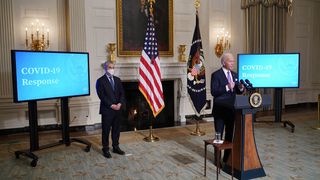
The Biden administration
On assuming office, President Biden moved to revoke several decisions of the former administration pertaining to global health. As pledged during the election campaign, on his first day in office, President Biden retracted the Trump administration’s effort to withdraw the United States from the World Health Organization.39 The day after the inauguration, the administration released its National Strategy for COVID-19 Response and Pandemic Preparedness in which restoring US leadership and advancing health security to be better prepared for future health threats was identified as one of seven priority goals.40 Coinciding with the strategy document’s release, Dr Anthony Fauci confirmed to the World Health Organization’s Executive Board that the United States would join the COVAX initiative that seeks to provide two billion doses of COVID-19 vaccines to low and middle-income countries, increase technical cooperation, and re-engage in multilateral efforts to defeat COVID-19 and ensure enhanced preparedness.41 To assist in coordinating these efforts, the Biden administration has re-instituted the National Security Council Directorate on Global Health Security and Biodefense and pledged to reinvigorate the Global Health Security Agenda,42 both of which were initiatives of the former Obama administration but which had languished under President Trump.43 Further measures, such as creating a National Center for Epidemic Forecasting and Outbreak Analytics, advocating for the creation of a new United Nations facilitator for biological threats, and working with multilateral partners including the G7, G20, ASEAN, and African Union to strengthen preparedness are also outlined in the National Strategy.44
Table 5. Status of the Biden administration’s proposed actions on global health and pandemic response (as of 4 February 2021)
|
Action |
Requires Administrative or Congressional Action? |
Status |
|
Restore the National Security Council’s Directorate for Global Health Security and Biodefense |
Administrative |
✔ |
|
Rescind the Mexico City Policy |
Administrative |
✔ |
|
Restore funding to the United Nations Population Fund (UNFPA) |
Administrative |
✔ |
|
Release a National COVID-19 Response Strategy, including a strategy for international engagement |
Administrative |
✔ |
|
Restore funding to WHO and reverse Trump administration decision to withdraw from WHO membership |
Administrative |
✔ |
|
Support the Access to COVID-19 Tools (ACT) Accelerator and join COVAX |
Administrative/Congressional* |
✔ |
|
Create position of Coordinator of the COVID-19 Response and Counselor, reporting to the President |
Administrative |
✔ |
|
Develop a diplomatic outreach plan led by the State Department to enhance the US response to COVID-19, including through the provision of support to the most vulnerable communities |
Administrative** |
✔ |
|
Provide US$11 billion to support “international health and humanitarian response,” including efforts to distribute countermeasures for COVID-19, build capacity required to fight COVID-19 and emerging biological threats |
Congressional |
Proposed |
|
Ensure adequate, sustained US funding for global health security |
Congressional |
Proposed |
|
Expand US diplomacy on global health and pandemic response, including elevating US support for the Global Health Security Agenda (GHSA) |
Administrative |
Proposed |
|
Call for the creation of permanent international catalytic financing mechanism for global health security and work with international financial institutions, including multilateral development banks, to promote support for combating COVID-19 and strengthening global health security |
Administrative |
Proposed |
|
Call for the creation of a permanent facilitator within the Office of the United Nations Secretary-General for response to high consequence biological events |
Administrative |
Proposed |
Australian interests
Australia’s interests are best served by seeing the United States re-engage with the global health community, but it is unlikely the United States will return to the leadership role it once assumed. There are two key reasons for this. First, for at least the initial 12-24 months of the Biden administration, the government will be appropriately focused on containing the spread of the SARS-CoV-2 virus (commonly known as the coronavirus) throughout the United States. This is likely to focus resources and attention on the United States’ domestic situation in the near term. Second, several other countries sought to fill the leadership vacuum created in global health governance by the Trump administration's America First’ policies, and now appear unwilling to cede that influence, viewing the United States as an “unreliable ally.”45
Australia can play an important diplomatic role in supporting the United States — including the endorsement of its reliability as a trusted partner — where shared interests exist. It can also actively seek out a number of new opportunities to enhance US-Australia cooperation. Global health security is one such area. The Australian Government’s regional health security initiative that witnessed the creation of the Department of Foreign Affairs and Trade (DFAT)’s Indo-Pacific Centre for Health Security,46 the recently announced A$500 million regional vaccine initiative,47 and efforts between the US military and Australian Defence Force to strengthen civil-military health cooperation across the Indo-Pacific have provided a solid basis for further US-Australia cooperation.48 Strengthening and building on these existing initiatives, aligning development assistance to prioritise strengthening health systems and workforces, re-invigorating some of the health-related multilateral initiatives, and working constructively together to reform the World Health Organization offer a number of opportunities to not only counter moves by other countries to increase their influence throughout the region but also demonstrate a re-engaged and responsive United States.
Policy recommendations
- Initiate ministerial discussions for a joint regional health security initiative involving the United States, Australia, Japan and India. Renewed interest in ‘The Quad’ multilateral arrangement provides a key opportunity to now strengthen regional health security, which reflects long-standing shared interests by all four governments. Intra-regional vaccine production and distribution could provide an immediate area for collaboration while intergovernmental talks commence to identify new synergies and areas for cooperation in strengthening regional disease surveillance and response capacities.49
- Further strengthen civil-military cooperation in health security in the Indo-Pacific region. As documented in the 2019 AUSMIN statement on global health security,50 the US military Indo-Pacific Command and the Australian Defence Force have made good initial progress in strengthening civilian and military cooperation for health security. These efforts are only at a nascent stage though and can be further expanded via providing technical assistance and training to other militaries in the region engaged in health assistance. These measures would create new opportunities for military-military cooperation while also serving to strengthen civil-military norms and enhance regional stability and security.
- Strengthen and re-invigorate the Global Health Security Agenda (GHSA). The GHSA initiative was launched in 2014 under the Obama administration and offers a viable intergovernmental platform for supporting countries in the Indo-Pacific region to strengthen their capacities in disease detection, surveillance and response.51 The GHSA, which languished under the former Trump administration, could be relaunched and repurposed to collaborate with other multilateral institutions such as the Asian Development Bank and World Bank to provide targeted development assistance for regional health system strengthening and workforce capacity building. The GHSA could also be used constructively to develop consensus on key issues, such as reform of the World Health Organization and proposals to strengthen multilateral cooperation in global health security.
Activate the Australia-US-Japan trilateral infrastructure partnership
Context and background
Australia, the United States and Japan should activate trilateral mechanisms to support the private sector to take up infrastructure funding initiatives in the Indo-Pacific. Amidst the many upheavals of 2020, the value of infrastructure partnerships in the Indo-Pacific to Australian foreign and security objectives has fallen by the wayside. This issue matters because one of the most permanent ways in which China’s claims to regional leadership is being asserted is via the provision of the Indo-Pacific’s underpinning infrastructure. China’s Belt and Road Initiative (BRI) is providing essential transport and information connectivity to the region, however, BRI projects are not always transparent, nor do they meet global quality standards.
With the small and medium economies of the Indo-Pacific region looking to build critical infrastructure to meet the demands of their populations and growth, there is a small and fast-closing window of opportunity for Australia, the United States and Japan to capitalise on this moment.
Australia, the United States and Japan all agree that to provide regional partners with fair, open and ethical financing alternatives — and to compete effectively with the BRI, they must leverage the resources of the private sector. Leveraging private sector capital and expertise in our development agencies’ infrastructure programming is critical to increasing our impact and strategic success. With the small and medium economies of the region looking to build critical infrastructure to meet the demands of their populations and growth, there is a small and fast-closing window of opportunity for Australia, the United States and Japan to capitalise on this moment.
Launched partly in response to China’s BRI, in November 2018 Australia, the United States and Japan announced the Trilateral Partnership for Infrastructure Investment in the Indo-Pacific.52 The Trilateral Partnership aims to provide regional governments with an alternative, transparent source of infrastructure funding and emphasises working with the private sector to improve outcomes relative to purely state-financed programs like the BRI. In November 2019, the Trilateral Partnership announced the Blue Dot Network (BDN) — an initiative to reduce the risk for private investors by providing certification for government, private sector, and civil society infrastructure projects that met international quality standards.53 While primarily a certification body, it can also provide access to US$60 billion in capital in loans or equity through the US International Development Finance Corporation (US-IDFC). However, specific mechanisms remain to be determined.
Figure 7. Chinese investment and contracts in the Indo-Pacific, 2014-19 (US$ billions)
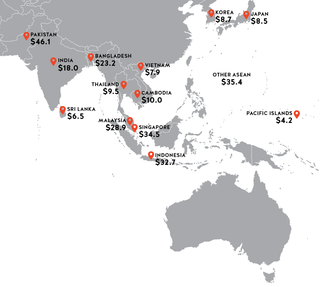
Despite efforts by the Trilateral Partnership, no public-private infrastructure projects have been cemented. The first and only project under this trilateral framework — an undersea fibre optic cable connecting Palau with the Indo-Pacific — is being done in partnership with the Palau Government rather than industry.54 The only other project on the horizon is an undersea cable connecting Santiago with Sydney55 but again, progress is slow — discussions between Canberra, Washington and Tokyo for a project focused predominantly on Australia and Chile will likely be continuing. Furthermore, other than BDN’s inaugural trilateral Steering Committee in January 2020 — which discussed a possible vision statement, membership criteria, and responsibilities56 — the BDN has yet to issue certification standards businesses can benchmark against more than a year later.
The Biden administration
As evidenced by the last two years, Australia’s, the United States’ and Japan’s development agencies’ infrastructure programming is not adequately structured to facilitate private sector take-up. In the case of the United States, not even a major restructure of its development agencies in 2018, whereby the Overseas Private Investment Corporation was transformed into the US-IDFC,57 has addressed this issue.
Although the US-IDFC possesses new development finance tools specifically designed to support private-sector-led projects such as small grants, loan guarantees, and equity investments, several factors including lacking communication and an inaccessible online interface are keeping business away.58 Following a meeting of the Trilateral Infrastructure Partnership with Vietnam in October 2020,59 the US-IDFC has yet to make any further public announcements regarding the progress or future direction of this initiative60
Australian interests
Supporting strategic infrastructure projects remains one of the most tangible ways to promote growth, demonstrate regional leadership, and further Australia’s national interests. Australia can maximise its impact in this space by working with like-minded partners and leveraging private-sector investment. However, clearly, there have been challenges to working trilaterally and getting the private sector on board.
Part of the difficultly is that Australia, the United States and Japan have separate, not always equal, infrastructure priorities, and the wide range of regional infrastructure needs can scatter focus, preventing the establishment of a project pipeline. In addition, to lift the BDN out of obscurity, some basic benchmarks must be set and the commercial benefits to certification proactively pushed out to business. Further, a review of the US-IDFC to understand the positive and negative effects of the restructure on attracting private investment could assist the United States to make adjustments as necessary, as well as help Australia and Japan decide if and how they should implement similar changes within their own development agencies.
Policy recommendations
Australia, the United States and Japan collectively should:
- Discuss the potential for a trilateral infrastructure hub established in Southeast Asia, initially dedicated to one aspect of infrastructure provision to the region. A central hub that focused on one major project, for instance, internet connectivity, would help narrow focus. The three countries could then reach out to industry partners in the field and cultivate and leverage business expertise to deliver similar projects to multiple countries over several years. A hub and single-area focus would help catalyse the Trilateral Partnership reputation in the region as a credible alternative to the BRI.
- Engage business via a regular Indo-Pacific infrastructure investment symposium to understand industry needs and promote interest in public-private partnerships.61 When feasible, Australia could propose an infrastructure symposium hosted in Southeast Asia bringing together Australian, US and Japanese governments and businesses. A symposium with latitude for private discussions could help government quickly understand where the roadblocks are for industry, including on regulatory concerns, as well as share information regarding government priorities on a country and sectoral basis.
- Clearly outline the BDN’s certification standards and procedures to access partner government funding. In addition, the rewards of certification to business should be explicit — for instance, allowing business to trumpet their prioritisation of environmental protection and sustainability as a responsible global citizen. The BDN could also be expanded to include base-level grants (non-repayable financial contribution provided under strict guidelines).
- Evaluate and reform development programming in the infrastructure space, based on the priority of maximising private-sector engagement. Recalibrating the orientation of relevant agencies to the specific needs of the private sector will greatly augment their capacity to leverage involvement. An assessment of infrastructure programming in all three countries should be conducted to identify how to make these programs more business-friendly.
Collaborate to combat misinformation and the threat of domestic extremism
Elliott Brennan
Context and background
Australia and the United States should support the establishment of a regular track 1.5 dialogue between government, business, and civil society leaders on the spread of violent extremism and its drivers.
The links between flawed information ecosystems and domestic extremism are now explicit and well-acknowledged following the failed Capitol insurrection on 6 January 2021. American security and intelligence agencies will be dealing with an emboldened extreme right-wing domestic terror threat for years to come as a result of the belief among many that the presidential election was rigged.62 But both the explosion of violence and erosion of fact were a long time in the making and long foretold.63 Australia is in a position to avoid the full fate of the United States in this regard. Working with American counterparts will be essential given that many of the solutions strike through American jurisdictions, like Silicon Valley.64
The COVID-19 pandemic was an accelerant — but not the root cause — for the linked information and extremism crisis facing the world today.
The COVID-19 pandemic was an accelerant — but not the root cause — for the linked information and extremism crisis facing the world today. Traditional news sources have been financially squeezed for years while the internet giants applying the bulk of the pressure have shirked any real responsibility for the content they host and promote, even in many cases when it was clearly extremist or outright conspiracy theorist content.65
The Trump administration quickened truth decay. The leader of the world’s oldest and most renowned democracy was disinterested in upholding the institutions that underpinned it. The COVID-19 pandemic then caused immense, health and financial hardship and contributed severe damage to social cohesion. Meanwhile, internet use soared in concert with prolonged lockdowns.66
With the above factors in place, the world was primed for the rapid scaling of misinformation within individuals’ information ecosystems and far-right groups and conspiratorial grifters were ready to exploit it.67

The Biden administration
The scale of this challenge does not pale in comparison to those like economic recovery, climate change or the rise of an authoritarian China. In fact, solving the United States’ domestic security and information crises is critical to each.
But like the other problems facing the Biden administration, these are intractable. The Republican Party is deeply divided. So long as conspiracy theories are flourishing within its ranks and giving those views legitimacy, the Biden administration will struggle to truly amend the problem.68
Australia and the United States are in the process of rewriting the online regulatory landscape. While Australia is at the vanguard of some issues like media bargaining, the US Congress now has the resolve to regulate the tech giants headquartered in its jurisdictions. The Biden administration is likely to increase the scope of anti-trust suits already filed against Google and Facebook, embark on data privacy and algorithmic transparency pushes and look closely at Amazon’s market position, including through the lens of its labour practices.
There is bipartisan consensus that Section 230 of the US Communications Decency Act (1996)69 — which does not consider internet platforms like Twitter and Facebook to be publishers — needs to be made fit for purpose. Democrats broadly seek to impose more responsibility on the bigger platforms, while Republicans accuse them of excessive censorship.70 This bipolarity will belie efforts to truly reform the media landscape in a way that reflects the realities of the 21st century.71
While any regulatory measures will take time, the threat of violence partly born of broken information ecosystems remains pressing. The Biden administration is taking steps to seriously address the threat of far-right extremism from a national security perspective, including a comprehensive threat assessment of domestic extremism being undertaken by the Director of National Intelligence in cooperation with the FBI and the Department of Homeland Security.72 This marks a definitive step into the post-9/11 paradigm of domestic security. Australia is also in the process of exploring the scope of these problems in the form of the Parliamentary Joint Committee on Intelligence and Security’s Inquiry into extremist movements and radicalism in Australia.73
Australian interests
Damaged information systems and right-wing extremism represent clear and present dangers for Australia. Right-wing extremism now accounts for as much as 40 per cent of the Australian Security Intelligence Organisation (ASIO)’s caseload in Australia, a dramatic increase from 2016 where it was estimated to be 10-15 per cent.74 Extreme right groups, including neo-Nazis, are increasingly embracing encrypted messaging platforms to organise in secrecy but have also held very public gatherings indicating that they are emboldened.75 In statements to parliamentary joint committees, both the Australian Federal Police and the New South Wales Crime Commission have testified that COVID-19 has driven a rise in right-wing extremism online.76 And, of course, it was an Australian man in Christchurch who conducted the deadliest explicitly extreme right-wing terrorist attack in recent decades.77

With a high-profile vaccine roll out, the threat of social unrest, violence and terrorism at associated crowded places is real and demands vigilance. Attacks on 5G towers rolled out in the United Kingdom and even New Zealand demonstrate the short leap from conspiracy-fuelled extremism to violence and terrorism.78
Policy recommendations
- Australia should support the establishment of a regular track 1.5 dialogue with the United States on countering violent extremism and its drivers. Australia and the United States have sound and long-standing intelligence-sharing arrangements through the Five Eyes collective and have also participated in sustained multilateral initiatives since 2001 through the United Nations and bodies like the Asia-Pacific Economic Cooperation (APEC) on the matter of counterterrorism.79 There is also a strong history of official agreements between their respective counter-intelligence coordination centres.80 But following multiple intelligence failures in the United States,81 and a rising threat in Australia,82 new foundations are needed. Both governments recognise this and are undertaking independent internal reviews into the changing domestic security landscape. These efforts would be complemented by convening government leaders in coordination with business leaders at the coalface, and civil society leaders and researchers who built an intimate knowledge of this emerging landscape before it presented itself fully as a threat to national security.
- Such a forum would help to sharpen both Australia and the United States’ existing participation in multilateral fora and would give necessary context allowing collegial and pragmatic discussions given Australia and the United States’ many shared values.
- Australia already participates in a similar dialogue on counterterrorism with the European Union83 and has previously participated in track 1.5 dialogues with the United States on critical issues like defence and cybersecurity.
- The dialogue’s scope should include the role of big tech. Both the United States and Australia are beginning a once-in-a-generation regulatory effort in this area and the new foundation must address the conditions that have let misinformation and conspiracy theories fester to the advantage of extremist recruiters.
Strengthen Indo-Pacific vaccine partnerships
Associate Professor Adam Kamradt-Scott
Context and background
Australia should actively engage the United States to partner in making COVID-19 vaccines available across the Indo-Pacific region, including via multilateral initiatives.
Several countries in the Indo-Pacific region are experiencing high levels of SARS-CoV-2 (commonly known as the coronavirus) transmission, which has contributed to significant demand for COVID-19 vaccines. In response, China and Russia have actively engaged in “vaccine diplomacy” to expand their influence and presence in countries of strategic significance to Australia, including Indonesia and Papua New Guinea.84 A well-coordinated, whole-of-region approach to the distribution and administration of COVID-19 vaccines will be critical to halting the ongoing transmission of the SARS-CoV-2 virus, avoid duplication of effort, and ensure cost-effectiveness of development assistance. A comprehensive Indo-Pacific vaccination strategy will also aid global economic recovery.
The Biden administration’s joint decisions to join COVAX and reverse the planned United States’ withdrawal from the WHO has already been welcomed by the international community as a sign of the United States’ willingness to re-engage in multilateral approaches to defeat COVID-19.
As part of its commitment to the Indo-Pacific region, Australia in November 2020 announced a Regional Vaccine Access and Health Security Initiative, which is designed to provide “safe, effective and affordable COVID-19 vaccines for the Pacific and Southeast Asia.”85 The initiative entails a A$500 million commitment over three years and will capitalise on the efforts undertaken by the Therapeutic Goods Administration (TGA) and the Department of Foreign Affairs and Trade (DFAT)’s Indo-Pacific Centre for Health Security (CHS) prior to the pandemic — to fast-track regulatory approval and distribution of medical products. This framework will accelerate the availability of COVID-19 vaccines across the region once they have received TGA approval.86
In contrast, the United States has provided little detailed information to date on how it will directly support countries throughout the Indo-Pacific region, nor how it will work with key regional stakeholders and allies to contain and eliminate the SARS-CoV-2 virus, including fair, rapid and equitable distribution of currently available COVID-19 vaccines.

The Biden administration
The primary focus of the Biden administration throughout 2021 is on containing and eliminating the spread of the SARS-CoV-2 virus throughout the United States.87
On 14 January 2021, then President-Elect Biden released the “American Rescue Plan” which aims to secure an additional US$1.9 trillion from Congress to launch a federal vaccination program, offer direct financial relief to Americans, and provide community support for struggling businesses and communities.88 In terms of international commitments, President Biden announced at the G7 meeting in February 2021 the United States will contribute US$4 billion towards the COVAX initiative,89 a multinational arrangement aiming to provide COVID-19 vaccines to low and middle-income countries that might otherwise lack timely access.90 Given the Trump administration had declined to join COVAX, pledging instead an ‘America First’ vaccine policy,91 the Biden administration’s joint decisions to join COVAX and reverse the planned United States’ withdrawal from the World Health Organization has already been welcomed by the international community as a sign of the United States’ willingness to re-engage in multilateral approaches to defeat COVID-19.
Yet while the Biden campaign released a series of foreign policy statements on restoring American leadership and working to improve relations with Central America and Africa,94 no equivalent policy positions were outlined on the Biden team’s future engagement with the Indo-Pacific region or China specifically. This has led to widespread speculation on how President Biden will approach wider US engagement in the Indo-Pacific.95
Australian interests
Australia has a number of intersecting interests regarding COVID-19 vaccines that will be best served by a more regionally engaged United States. Given the combined population size of Southeast Asia and the Pacific islands, Australia’s regional vaccine initiative will be insufficient to meet the region’s needs. New Zealand has pledged its excess COVID-19 vaccines to Pacific island countries for free,7.13 which will help prioritise Australia’s support for Southeast Asian countries; but additional international contributions will be critical to containing the SARS-CoV-2 virus throughout the region and reopening tourism and trade. Joint US-Australia-New Zealand vaccine arrangements, in addition to support provided via the COVAX initiative, will also potentially help counter some of the efforts by China and Russia to use their vaccines to increase their regional influence.
What is the COVAX initiative?
COVAX is a joint initiative between the World Health Organization, the Coalition for Epidemic Preparedness Innovation (CEPI) and Gavi, the Vaccine Alliance (a global public-private global health partnership). The initiative aims to help facilitate the rapid development and manufacture of COVID-19 vaccines and ensure their equitable and fair distribution to all countries.92 COVAX has guaranteed it will purchase two billion doses of COVID-19 vaccines and distribute them to countries so that they can vaccinate at least 20 per cent of their population. The initiative is particularly important for low-income countries that would otherwise struggle to gain access to COVID-19 vaccines due to cost barriers, ‘vaccine nationalism,’ and supply issues due to limited production capacity. At least five vaccine manufacturers have currently signed supply agreements with COVAX, and it is expected COVAX will commence distributing vaccines in the first quarter of 2021.93
Specifically, China’s pledge to make its COVID-19 vaccines a ‘global public good’ has been accompanied by high-level diplomatic missions to promote its vaccines to countries across the region and further abroad.97 These vaccine diplomacy/soft power efforts have been recognised as an attempt to make “strategic inroads” into the region,98 with some characterising China’s efforts as building a “Health Silk Road” commensurate with the Belt and Road Initiative.99 Yet concerns remain about the efficacy of some of China’s COVID vaccines,100 and information is beginning to emerge of significant price variation in advance purchase agreements between countries,101 raising the prospect that Indo-Pacific countries might face having to vaccinate their populations twice at considerable expense if current vaccines provide insufficient protection. It is therefore in Australia’s short, medium and long-term interests that proven safe and effective vaccines are made available, distributed and administered as soon as possible. The United States’ support for an Indo-Pacific vaccine drive will be critical to ensuring that outcome.
Policy recommendations
- Establish a joint US-Australia-New Zealand COVID-19 vaccine taskforce to pool procurement and work with partners to coordinate vaccine distribution and administration across Southeast Asia and the Pacific. Vaccine manufacturers have already been identified as elevating prices for individual countries, which is best countered by multinational purchasing platforms. A US-Australia-New Zealand taskforce can work with countries in the region and international platforms like the COVAX initiative, and the World Health Organization’s South-East Asia and Western Pacific regional offices, to coordinate the purchase, delivery and administration of COVID vaccines. A joint taskforce will also help prevent duplication of effort, ensure cost-effectiveness of development assistance, prevent wastage, and facilitate a more rapid distribution and administration across the region.
- Enable additional financing options through multilateral institutions to increase manufacturing and vaccine availability. The COVAX initiative provides one of the most important platforms for distributing an initial supply of COVID vaccines to countries eligible to receive official development assistance, but the initiative remains significantly underfunded. In addition, COVAX will not meet countries’ full needs, necessitating additional measures. Enabling financing arrangements via the Asian Development Bank to support the construction of new manufacturing facilities, and the World Bank to support direct procurement from existing manufacturers will supplement the COVAX initiative. Helping countries gain access to proven safe and effective vaccines directly from manufacturers via loans and financing arrangements will also circumvent indemnity problems associated with donated vaccines and place decision-making back in the hands of national governments.
- The United States and Australia lead an initiative in the World Trade Organization to waive intellectual property rights to rapidly upscale regionally-based manufacturing of approved, efficacious vaccines, diagnostics and therapeutics. Intellectual property (IP) barriers on COVID vaccines, diagnostics and therapeutics via the Agreement on Trade-Related Aspects of Intellectual Property Rights (TRIPS) framework continue to impede rapid upscaling of critical medical products to contain the SARS-CoV-2 virus.102 This is despite the fact the TRIPS agreement permits countries to waive IP considerations in national emergencies.103 Australia, the United States, and other like-minded countries like Canada and the United Kingdom could work constructively to waive or partially waive existing IP protections, allowing for vaccine producers in India, Indonesia, Vietnam and South Korea amongst others, to commence manufacturing. This will be particularly important in advance of second-generation COVID vaccines to counter currently circulating and future variants.
Find common areas of cooperation in bolstering resilience to climate change
Professor Simon Jackman and Jared Mondschein
Context and background
Australia and the United States should co-invest in the development of clean energy solutions.
The Biden administration is pursuing an ambitious climate agenda, its elements signalled well in advance during the 2020 presidential election campaign. Australian interest in this policy domain runs high, with several commentators speculating that climate change policy will become a pressure point between the Biden administration and the Morrison government104 and hence, a rare but vivid instance of public disagreement in the US-Australia relations.
Within a month of taking office, the Biden administration rejoined the Paris Climate Accord, cancelled the Keystone pipeline and restored environmental regulation and rule-making processes rolled back by the Trump administration.105 Biden also announced the intention for the United States to have a “carbon pollution-free electricity sector no later than 2035” and be “on a path” to achieve net-zero emissions, economy-wide, by 2050.106 These policy changes and aspirations give voice to the Biden campaign’s plan to spend around US$2 trillion on “a clean energy revolution and environmental justice.”
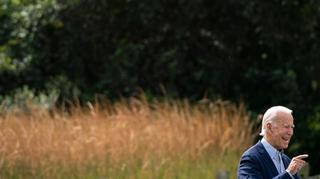
But of special note is the way that the Biden administration intends for climate change considerations to feature heavily in US foreign and trade policy, particularly whether or not it will implement a campaign pledge of “carbon adjustment fees or quotas on carbon-intensive goods from countries that are failing to meet their climate and environmental obligations.”107 Among Biden’s first announcements after winning the election was the appointment of John Kerry as Special Presidential Envoy for Climate and designating this position as a member of the National Security Council. Kerry’s seniority and status further underscore the importance of the Biden aspiration for the United States to lead international efforts on climate change.
Two features of Biden’s proposals warrant elaboration.
First, Biden’s proposals enjoy deep support among the Democratic rank-and-file, while being carefully tailored to appeal to moderate and independent voters, or at least not alienate those segments of the electorate. During the presidential campaign, Biden insisted that his climate change policy was more moderate than the “Green New Deal” and that his administration would not oppose fracking though he simultaneously advocated massive investments to steer the US economy to a low-carbon future.108
Many of Biden’s climate and energy policy aspirations are not controversial and are widely endorsed (if tacitly) throughout American society. Well before Biden’s campaign, leading multinational firms, many US states, and institutions in civil society had already committed to net-zero carbon emissions by 2050 — or earlier.109 From this perspective, the surprise is not so much the apparent boldness of Biden’s policies, but the trenchant opposition of the Trump administration to climate change policy.
Second, there is broad support for injecting climate change considerations into foreign policy, trade and national security policy. As reported in Figure 3, survey research by the United States Studies Centre finds that 68 per cent of Americans rate dealing with global climate change as a very or somewhat important goal of US foreign policy.
More specifically, as shown in Figure 8, the same survey finds 46 per cent of Americans agree that the US Government should “reward countries who do more to stop climate change with more favourable trade deals, and impose costs on those that do not.” Only 20 per cent of Americans are opposed to an explicit link of preferential trading arrangements with climate change action. Nearly three-quarters of Biden voters agree with this proposition, highlighting the depth of political demand on climate change action in the Democratic base.
Figure 8. Biden supporters overwhelmingly want US trade policy linked to climate change
Percentages of respondents giving each indicated response, by 2020 presidential vote, January 2021 survey
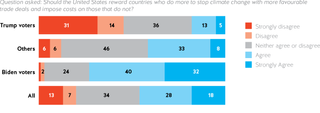
The Biden administration
Domestic US politics will limit broader congressional legislation on climate change (see earlier chapter for details). But actions already undertaken by the US executive branch span the “whole of government,” with practically every US federal department and agency — from Energy and Transportation to Treasury, Commerce and the US Trade Representative — directed to commit to climate initiatives via executive orders issued by President Biden.110
Biden campaign promises about imposing costs on international climate laggards have thus far not translated into policy. Instead, the Biden administration has focused on positive measures, stressing that a “zero emissions future offers remarkable opportunity for business, for clean, green jobs, for economic growth”111 in an effort to “build back better” — linking climate change policy with popular initiatives such as investing in US infrastructure and economic recovery from the COVID-19 pandemic.
Australian interests
Climate Envoy John Kerry is still building his office and the details of the international-facing elements of Biden’s climate policy remain a work in progress, as are any first-order implications for Australia.
In the first week of the Biden administration, a phone call between Kerry and Australia’s Minister for Energy and Emissions Reduction Angus Taylor appeared to show agreement around the importance of driving technological solutions to climate change, flagging enhanced US-Australia coordination on research and development into low-carbon energy technologies.112 Yet in late February 2021, Kerry noted to a public audience that “Australia has had some differences with us, we’ve not been able to get on the same page completely”113 — the closest the Biden administration has come to criticism of Australian climate change policies.114
Carbon-based, border adjustment taxes remain an unsettled subject of debate within the administration, albeit one getting increasingly more attention.115 At the moment, Australia may need to be more concerned about the implementation of such a tax by the European Union, where the debate is more developed, and the likelihood of implementation may be as early as 2023.116
in late February 2021, Climate Envoy John Kerry noted to a public audience that “Australia has had some differences with us, we’ve not been able to get on the same page completely” — the closest the Biden administration has come to criticism of Australian climate change policies.
Australia will likely escape overt, first-order pressure from the United States on climate change, for a number of reasons.
- Americans well understand that Australia is on the “front lines” with respect to China and Beijing’s economic coercion — that China is subjecting Australia to economic coercion — and that Australia’s US alliance credentials are impeccable. Biden administration officials have already pledged to “stand shoulder to shoulder” with Australia on Chinese economic coercion.117
- The Australian alliance enjoys broad and deep support in the US Congress, with several of Australia’s strongest backers in the US Congress themselves hostile to Biden’s climate change agenda.118
- Until the United States makes credible commitments to lower emissions itself — such as a binding national policy like a carbon tax and not merely aspirations or the uneven and uncoordinated mix of state and local initiatives — Australia has a strong moral case.
Biden administration policies in the “technology-not-tax” arena align with the Coalition’s preferred approach to climate, emissions and energy policy119 and lie more soundly in the small set of politically-viable climate change policies likely to pass the US Congress.120
Beyond the ever-increasing international and domestic political pressure to do more on climate change, Australia faces the long-term challenge that three of its top destinations of Australian fossil fuels exports — Japan, Korea and China — have committed to net-zero carbon emissions in the coming decades.
The very same fossil fuel linkages to Asia may well be repurposed to provide low- or no-carbon energy to Asian markets. Australia is uniquely situated to become a clean energy superpower if it implements the right policies and can be at the technological frontier in low-carbon energy production, transmission and storage.121 Solidifying energy R&D ties with the United States would better facilitate such efforts.
Policy recommendations
- Continue monitoring the development of internationally-oriented elements of US climate change policy and their connection to US security and strategic policy. Facing little room to move on climate change in the Congress — but pent-up political demands from its supporters for action — the Biden administration will be attracted to the international policy arenas as venues for notching “wins” on climate. Australia has multiple strategic and commercial interests at stake, especially should energy and emissions be part of any “grand bargain” between the United States and China.
- Establish a clean energy partnership focused on innovating new low and no-carbon solutions. The United States and Australia have overlapping interests in maximising investments into clean energy technology. They also have committed, or are seeking to commit, significant investments in clean energy. The challenge for the two countries is to calibrate the R&D portfolio and the potential sharing of intellectual property to minimise inefficiencies, taking advantage of the plethora of US capital and expertise in the area and the simultaneous abundance of Australian energy resources. Clean energy innovations could be considered as a part of a “skinny deal” Digital Trade Agreement that would act as an addition to the Australia-US Free Trade Agreement.
Organise the alliance for collective defence
Ashley Townshend and Brendan Thomas-Noone
Context and background
Australia and the United States should advance operational-level coordination within and beyond the alliance to facilitate a collective approach to deterrence and defence in the Indo-Pacific. It is now well accepted in Washington and Canberra that the United States cannot uphold a favourable balance of power in the region alone.122 China’s increasingly large and sophisticated military is eroding the foundations of American power in the Western Pacific.123 While the Pentagon is working to find technological and operational offsets to the problems China presents, it faces rising budgetary pressures, daunting modernisation challenges and a host of unrelated domestic and global commitments.124 Australia is heavily implicated by these trends. Canberra has core interests in the preservation of a stable strategic order in the Indo-Pacific and a key role to play in upholding this order alongside the United States and other allies and partners.
Yet the US-Australia alliance lacks the tools to implement a strategy of collective defence. Despite a very high level of military interoperability, Canberra and Washington have not developed processes for coordinating military strategy, undertaking combined contingency planning or assigning roles and responsibilities for regional operations.125 Such measures are required to transform the alliance into a credible vehicle for deterrence and defence. Some regional precedents exist. In 1951, the US and Australian navies signed the Radford-Collins Agreement to coordinate maritime security responsibilities in the Indo-Pacific — the only mechanism of its type in the alliance which, while still in force, needs substantial updating.126 Later in the Cold War, the United States and Japan pursued similar, if more comprehensive, approaches to dividing operational responsibilities for anti-submarine warfare (ASW) and maritime blockades in the Western Pacific.127 These are useful constructs for the United States and Australia to consider when thinking about collective defence operations today.

The Biden administration
The Biden administration appears open to exploring new approaches to collective defence in the region with militarily capable allies like Australia. Whether this translates into action on sensitive issues — such as reading key allies into US military planning at early stages of development — is yet to be seen.128 President Biden’s Deputy Secretary of Defense, Kathleen Hicks, has, for instance, written about the need for a “federated” approach to Indo-Pacific defence policy.129 This would see the United States and key regional allies integrate military capabilities into comprehensive security architectures to achieve common approaches to a range of strategic policy issues: from expanding defence value chains to developing joint operational concepts. Hicks has also proposed co-developing and co-producing an auxiliary supply ship to offset the costs and expand the capacity of the United States and its allies to sustain and resupply forward-deployed forces during high-end conflict.130
As China’s capacity to project power into Australia’s northern approaches intensifies, and as the United States’ interest in Australia as a strategic location and regional military partner grows, Canberra and Washington will find their security interests more closely aligned than at any time in the 70-year history of the alliance.
Pursuing new forms of defence networking with regional militaries is also high on the Biden team’s agenda.131 This is likely to build on common operating platforms like the P-8 maritime surveillance and ASW aircraft that is operated by the United States, Australia and India. As some incoming administration officials have underscored, common capabilities allow easier integration and data sharing, providing ripe opportunities for coordinated maritime patrols in the Indo-Pacific.132 Others highlight the need to find “complementarities” between US and allied forces, which could facilitate more effective combined presence deployments and have potential to develop into standing maritime task forces.133 However, as these proposals will require major changes to the way the US military has cooperated with partners for the past three decades, they will encounter significant bureaucratic and political hurdles in both Canberra and Washington.
Australian interests
Australia has a strategic interest in minimising these hurdles, particularly in Southeast Asia and the Pacific. As the United States’ unilateral ability to uphold the regional order declines, contributing to a coalition defence arrangement that preserves stability and halts Chinese military expansion is Canberra’s next best strategic policy option.135 This idea lies behind Australia’s 2020 Defence Strategic Update and the government’s emphasis on advancing both independent and allied capabilities to deter major powers and shape the regional strategic environment.136 Building mechanisms for US-Australia military coordination on key region-wide tasks, such as ASW operations and theatre missile defence, are the building blocks of such a strategy — even if allied integration is not desirable or possible across all capabilities and mission sets. This approach may also assist Canberra to realise its long-standing goal of tethering Washington more firmly to its immediate region. The reason for this is clear: As China’s capacity to project power into Australia’s northern approaches intensifies, and as the United States’ interest in Australia as a strategic location and regional military partner grows, Canberra and Washington’s security needs in Australia’s Indo-Pacific neighbourhood are becoming more closely aligned than at any time in the 70-year history of the alliance.
Figure 9. Major anti-submarine warfare exercises involving Australia and the United States 134
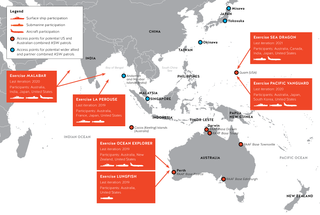
Policy recommendations
Australia and the United States should organise the alliance for collective defence in an active but cautious way, focusing on two immediate lines of effort:
- Explore options for combined strategic and military planning centred around high-value scenarios and maritime operations. For collective defence to function at an operational level, the US military must read-in, involve and collaborate with Australia — and other close allies — at the earliest possible stage of the planning process.137 This is an unrealised objective of the 2018 US National Defense Strategy.138 Canberra and Washington should pursue this goal in a stepwise way, beginning with contingency planning for Pacific and Southeast Asian scenarios that could involve a limited use of force by China. Both allies should also explore combined command structures for peacetime surveillance and ASW patrols between Cocos Islands, Northern Australia and Guam; broadening these to include India and Japan, with access to the Andaman and Nicobar Islands and Japanese archipelago.
- Update and expand the 1951 Radford-Collins Agreement. Although this non-binding navy-to-navy arrangement worked to coordinate allied maritime responsibilities in the Cold War, it is too limited for today’s security environment.139 New operations and geographic settings should be explored to include the Indian Ocean, Southeast Asia and South Pacific, with a revised agreement accounting for recent force posture initiatives and offering a basis for new ones. A service-level agreement to coordinate — rather than integrate — national responsibilities on key maritime tasks may be a less politically sensitive way to progress towards combined operations. Ideally, any revised agreement should be expanded beyond the maritime domain to include air, land, space and cyber forces, either jointly or in separate service-level arrangements.
Expand allied force posture initiatives in the Indo-Pacific
Brendan Thomas-Noone
Context and background
Australia and the United States should launch a new generation of Indo-Pacific posture initiatives. Drawing on the 2020 Force Posture Working Group, the establishment of new facilities, operating locations and sustainment hubs will enable a more forward Australian Defence Force (ADF) posture. This would provide options for a range of regional deterrence and defence activities, and help sustain US military presence in the Indo-Pacific. New US or allied posture initiatives in Australia and the region should focus on maintaining and expanding operational access to Southeast Asia, enabling enhanced capacity building and support for vulnerable regional states, and underwriting deterrence missions.
Realigning each country’s regional force posture has been a major focus for Australia and the United States over the past decade. Canberra has upgraded military infrastructure and presence across northern Australia in an attempt to grow the capacity and capability of the ADF to surge forward in a conflict.140 Results have been mixed. While upgrades to military facilities above the 26° South parallel have proceeded in the intervening years, the overall number of ADF personnel has declined.141 Similarly, the Obama administration’s “rebalance to Asia,” launched in 2011, has proceeded with a highly questionable level of progress. Its aim was to achieve a military footprint that was “geographically distributed, operationally resilient and politically sustainable.”142 Some significant realignments commenced and are still underway, but overall progress has been stilted, with US forces in the region operating from large concentrated bases much as they were in 2011.143

The Biden administration
There is broad bipartisan recognition in the United States that its Indo-Pacific force posture is ill-equipped to meet China’s military challenge. This includes members of Biden’s national security and defence teams, many of whom have supported ongoing efforts to redistribute US forces, reinvigorate existing initiatives and forge new ones. Secretary of Defense Lloyd Austin supports the continued redistribution of US forces across the Indo-Pacific, including the major realignments initiated under Obama’s rebalance.144 But American thinking about allied force posture initiatives — and how US infrastructure and access in the region can be leveraged to bolster allied reach and capacity — has been more limited. Some ideas have included Australia rotating naval assets to a standing maritime task force or progressing the networking of exercise and test ranges to enable integration.145 The Biden administration has inherited a long-running Joint Force effort to develop new operational concepts for the Indo-Pacific, which will require new partners, access locations and regional infrastructure, likely leading to a degree of bureaucratic momentum as new initiatives are considered by US military services.146
New American or allied posture initiatives in Australia and the region should focus on maintaining and expanding operational access to Southeast Asia, enabling enhanced capacity building and support for vulnerable regional states, and underwriting deterrence missions.
There is general support for further resources in Congress for a new slate of force posture changes in the region. This is critical for any substantial realignment of US military forces considering the significant infrastructure and logistic spending that may be required.147 The passage of the 2021 National Defense Authorization Act by Congress — which established the Pacific Deterrence Initiative (PDI) — in late 2020 is a positive step in this direction. The PDI, a US$2.2 billion account that is intended to directly fund and upgrade the United States’ military footprint in the Indo-Pacific, will be a central tool for the Biden administration and an opportunity for allies.148
Australian interests
Australia has a significant interest in shaping and delivering new force posture initiatives that will both enable the objectives of the 2020 Defence Strategic Update and improve the sustainability of US military presence in the region. Canberra’s new strategic policy blueprint has underscored the need for Australia to develop the ADF’s ability to deliver deterrent effects, contribute to coalition operations and respond to grey zone activities in Australia’s immediate region.150 This will require an expanded list of potential operating locations, bases and sustainment hubs in Southeast Asia, the Pacific and the northeast Indian Ocean. Canberra will need to strengthen existing relationships with nations in those areas as well as leverage US access arrangements where mutually beneficial. While Australia is already reorientating its domestic force posture, upgrading airfields, developing new port facilities and expanding training ranges across the northern part of the country and in territories like the Cocos Keeling Islands and Christmas Island, much more will be required to support Australia’s more active strategic policy agenda.151
Figure 10. Current and potential allied force posture in the Indo-Pacific149

Policy recommendations
Using the recently established bilateral Force Posture Working Group, Australia and the United States should:
- Establish a US maritime or naval force posture initiative in Australia. With US Air Force and Marine initiatives well underway, a naval or maritime element would provide innumerable benefits and help sustain US military presence in the region. The US Navy faces a series of structural challenges, including growing demands on an overworked fleet, budgetary pressure and an increasingly active and capable China.152 Options to alleviate some of these pressures could include developing a maintenance or rotational deployment capability in Western Australia or providing a logistics hub for forward deployed lift assets and US Navy transports to enable more effective supply of dispersed forces.153
- Explore combined force posture initiatives in Australia’s immediate region. As both allies realign their respective force postures, there may be advantages to combining resources by establishing select combined facilities. This is already being trialled through the redevelopment of a naval facility on Manus Island.154 While the United States and Australia have substantially different requirements and interests in how they structure forces in the region, there are key overlaps — such as developing new operating locations that would facilitate greater Indian Ocean access or bolstering efforts aimed at easing logistics challenges.
- Facilitate greater Australian use of US operating locations across the Indo-Pacific. Australia’s Defence Strategic Update calls for an ADF that is capable of executing independent deterrent effects in Australia’s immediate region, countering grey zone coercion and joining wider coalition operations when required. This demands a more agile operational posture. In the future, elements of the ADF may need to move rapidly throughout the region, leading operations, contributing to coalition high-end deterrence missions and conducting independent manoeuvres in the same deployment.155 Greater access to US operating locations in Guam, the Philippines, Singapore and elsewhere would support the ADF in these tasks and help to augment Australia’s contribution to upholding the regional order.
Strengthen coordination on countering maritime coercion
Ashley Townshend and Toby Warden
Context and background
Australia and the United States should strengthen coordinated efforts to counter Chinese grey zone activities in maritime Southeast Asia and the Pacific. Over the past decade, China’s use of maritime coercion has undermined security, sovereignty and stability within Australia’s immediate region, and contributed to the expansion of its strategic influence. These activities have intensified during COVID-19. Chinese naval and coastguard vessels are intimidating their Southeast Asian equivalents, disrupting fishing ships and hydrocarbon exploration platforms, and supporting maritime militias in disputed waters.156 China’s geopolitical presence is also growing, enabled by unilateral administrative arrangements and the construction of dual-use infrastructure by state-owned firms.157 These activities are eroding the regional strategic status quo without resorting to conflict and, underwritten by China’s expanding military reach, threaten to bring about a Chinese sphere of influence.
Washington and Canberra agree that a more forward-leaning approach is required to counter China’s maritime grey zone activities.158 Both have worked independently, together and with like-minded partners to help Southeast Asian and Pacific nations defend their maritime rights and interests. This has included diplomatic solidarity, presence operations in support of state and non-state actors facing Chinese intimidation, and intelligence, surveillance and reconnaissance (ISR) assistance and information-sharing initiatives to illuminate China’s coercive activities.159 Such efforts should be expanded and improved through closer strategic coordination within the alliance.

The Biden administration
Biden’s national security team appears highly supportive of this agenda. The National Security Council’s (NSC) Coordinator for the Indo-Pacific, Kurt Campbell, has advocated strengthening multinational thresholds and penalties for low-level coercion.160 Similarly, US Deputy Secretary of Defense, Kathleen Hicks, has emphasised the need to reform coordination mechanisms and decision-making processes to address grey zone maritime activities in concert with allies and partners; and has called for “strengthening collaborative planning” more broadly.161
Over the past decade, China’s use of maritime coercion has undermined security, sovereignty and stability within Australia’s immediate region, and contributed to the expansion of its strategic influence. These activities have intensified during COVID-19.
Two main lines of effort have been proposed to operationalise this collective approach — most of which align with the Pentagon’s Indo-Pacific Maritime Security Initiative (MSI) which seeks to build partner capacity, enhance information-sharing and boost multinational cooperation.162 The first focuses on military and maritime capacity building. This includes bolstering partner capabilities in anti-access/area denial systems, ISR platforms, maritime law enforcement, and maritime patrol and interdiction, as a means of empowering regional countries to push back more effectively on grey zone activities.163 This could extend to widening the role of the US Coast Guard to train and exercise with Indo-Pacific counterparts.164
The second line of effort involves the provision of direct operational and intelligence support to partners on the frontline of Chinese coercion. Such measures are intended to increase the stakes for Beijing should it seek to disrupt lawful maritime activities and help regional states defend their maritime rights more effectively. This could include an expansion of coordinated patrols and presence activities by allied navies and coastguards in order to prevent coercion, assure partners and respond to maritime intimidation in real time;165 and would involve improved efforts to foster shared maritime domain awareness across the region.166
Table 6. Recent examples of Chinese maritime coercion in Southeast Asia and the Pacific167
|
Date |
Description |
|
December 2019 — January 2020 |
China deployed maritime militia ships, supported by the Chinese Coast Guard, to waters off the Natuna Islands, prompting Indonesia to dispatch fighter jets, warships and coast guard vessels to patrol the region |
|
February 2020 |
People’s Liberation Army Navy ship aimed its weapon control system at a Philippine Navy ship in the Spratly Islands |
|
February 2020 |
A Chinese state-owned company made significant progress expanding and upgrading Momote Airport, near Lombrum Naval Base |
|
March 2020 |
China deployed a fleet of maritime militia ships to the Union Banks in the Spratly Islands |
|
March 2020 |
China opened two new research stations on Fiery Cross Reef and Subi Reef in the Spratly Islands, which include defence silos and military-grade runways |
|
April 2020 |
Chinese Coast Guard ship rammed and sunk a Vietnamese fishing boat near Woody Island |
|
April 2020 |
A Chinese research ship, Haiyang Dizhi 8, accompanied by Chinese Coast Guard and maritime militia vessels, sought to intimidate the Malaysian-chartered drillship, West Capella, operating in Malaysia’s Exclusive Economic Zone |
|
November 2020 |
A Chinese company signed a memorandum of understanding with the Papua New Guinean Government to develop a comprehensive multi-functional fishery industrial park on Daru Island |
|
January 2021 |
National People’s Congress adopted the Coast Guard Law allowing the Chinese Coast Guard to fire on foreign vessels |
Australian interests
Australia has a stake in all these initiatives. As the 2020 Defence Strategic Update points out, grey zone activities are targeting Australian interests in an open and stable region and must be addressed through active efforts to shape the strategic environment and deter coercive actions.168 Yet, while Canberra and Washington have a shared understanding of the grey zone challenge, their interests and threat perceptions are not entirely symmetrical.169
This has led to coordination problems. Above all, the alliance has not identified common red lines with regard to Chinese grey zone tactics such as island-building, maritime intimidation or the use of paramilitary forces. This stems from divergent appetites for military, strategic and political risk. While hard to achieve, shared thresholds for action are crucial for increasing Beijing’s risk calculus and assuring regional partners of allied support.170 Moreover, Australia and the United States do not prioritise the policy tools for countering grey zone coercion in exactly the same way. For instance, in the Pacific, where Australia has important interests in regional leadership, Canberra has advanced a whole-of-government approach to bolstering resilience; whereas US initiatives have often been led by the Pentagon and not always dovetailed with Australian efforts.171 Finally, the alliance has yet to deliver a genuinely combined approach to maritime domain awareness and counter-coercion operations — a task that requires deeper ISR integration, unmanned vehicles for persistent situational awareness and, potentially, the inclusion of information, electronic warfare and special operations forces.172
Policy recommendations
Australia and the United States should broaden and deepen their combined approach to countering maritime grey zone activities in the following ways:
- Establish formal channels for coordinating counter grey zone activities in maritime Southeast Asia and the Pacific. Given the number of agencies involved in addressing this challenge, strong central leadership is needed from Canberra and Washington. Indeed, as the recent Pacific Fusion Centre issue has highlighted, even considered actions can create unhelpful duplication.173 A coordinating mechanism could identify strategic lines of effort, functional roles and responsibilities and, ideally, undertake planning for specific initiatives and operations bilaterally. It could be nested within the new Indo-Pacific Coordination Mechanism or established between appropriate national leads, such as the NSC and Department of Prime Minister and Cabinet. A bilateral, or trilateral including Japan, working group within the Maritime Security Initiative could help to streamline regional capacity building, intelligence sharing and maritime domain awareness efforts.
- Expand and improve the coordination of current efforts to support third parties through maritime presence operations. Enhanced multilateral maritime presence in close proximity to actual or potential Chinese intimidation of regional vessels is likely to have a deterrent effect. While the so-called West Capella standoff in April 2020 signalled US and Australian resolve to deliver this effect in an opportunistic way, future activities would benefit from pre-planning on red lines, protocols for action and greater information sharing.174 Given the asymmetry between Chinese maritime forces and smaller US and Australian fleets, coastguard and border force agencies have a role to play.175 This could be enabled by rotating or deploying or a US Coast Guard detachment to Australia to establish patterns for allied patrol operations.176
Advance defence industrial base integration
Brendan Thomas-Noone
Context and background
Australia should pursue more innovative ways to advance defence industry integration with the United States, including by coordinating with Canada and the United Kingdom. A collective approach to defence industrial base integration between the United States and its close allies is essential to maintaining a conventional military edge in the Indo-Pacific. China is on a path to match — if not surpass — the combined R&D spending of the United States, Canada, the United Kingdom, Australia and New Zealand by the mid-2020s.177 Harnessing new technologies, integrating them into allied defence forces and ensuring their affordability for middle powers like Australia are critical steps to achieving a favourable balance of power in the region178
The US Congress recognised these challenges in 2017 when it expanded America’s National Technology and Industrial Base (NTIB) to include Australia, the United Kingdom and Canada. Its aim was to deepen connections between allied defence and national security industries, eventually creating a defence free trade zone.179 However, meaningful progress on implementing this framework has stalled. This is because Washington has failed to address core hurdles to further integration, such as its treatment of US allies under extraterritorial export controls like the International Traffic in Arms Regulations (ITAR).
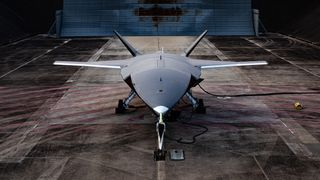
The Biden administration
The prospects for substantial defence industrial integration under the Biden administration are dim. Biden’s campaign platform was clear: the Trump administration had let too many foreign companies bid on US Government contracts, including those issued by the Pentagon, undercutting American manufacturing and industrial jobs. Biden has already moved to fulfil his campaign promise, issuing an executive order strengthening “Buy American” regulations during the first week of his administration.180 The new order centralises much of the decision-making power over waivers for the regulations within the White House, expands the list of products covered and closes some well-known loopholes.181
These domestic priorities are clearly at odds with the spirit of further industrial integration with close allies. Nevertheless, some senior Biden administration officials have voiced support for the strategic logic of deeper integration. In her written response to questions from Senators during her nomination process for Deputy Secretary of Defense, Kathleen Hicks stated that the NTIB should be “leveraged wherever possible” to strengthen defence relationships with allies. The NTIB would be part of the answer in encouraging competition within the US industrial base, she added, as well as fostering “collaboration, competition and innovation to ensure a healthy supply chain.”182
Figure 11. Trends in national research and development
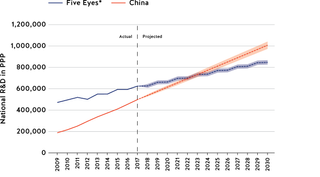
How this conflict between Biden’s domestic agenda and the requirements of allied strategic policy coordination will be resolved is uncertain. The president may be the decisive factor. Importantly, it was during Biden’s chairmanship of the Senate Committee on Foreign Affairs that the Australia-US Defence Trade Cooperation Treaty passed in 2008. Biden — and his staff director at the time, now Secretary of State Antony Blinken — raised concerns about the integrity of the treaty, questioning the reliability of Australia’s export control regime and the risks of establishing a precedent that weakens America’s ITAR rules.183 Today, further defence industrial integration may hinge on whether the president’s views and those of his closest advisors have changed over the past decade or can be influenced in office.
Australian interests
Australia has several overlapping interests in greater defence industrial integration with the United States. Canberra’s 2020 Defence Strategic Update prioritises the development of a robust domestic defence industry as a key pillar in ensuring the delivery and sustainment of Australia’s military modernisation efforts. Breaking down export barriers, facilitating better access to the US defence market and ensuring more equitable rules for intellectual property and collaboration are critical to this agenda.186 If progress is not made, Australian companies will be increasingly deterred from collaborating with the United States owing to fears that their products and intellectual property will be captured by its far-reaching export controls. Allies will instead network with each other to avoid the US system, as evident in the recent agreement between Boeing Australia, the Australian Department of Defence and the United Kingdom on sharing design materials for the unmanned Air Power Teaming System.187 Such activity deprives the United States of valuable innovation and niche technological capability.
Slow progress on the National Technology and Industrial Base
Australia has had recent success in pushing for further recognition of the importance of defence industrial integration at the highest levels of US political and national security leadership. The joint statement from AUSMIN 2020 noted the ongoing work of the AUS-US Defense Trade Working Group and promised to “help resolve defense trade issues of mutual concern, including on export controls.”184 But progress in this area is increasingly measured by the success of individual specialised or pilot projects, rather than the wholesale change originally envisioned by the NTIB framework. For instance, a recent Australia-US bilateral agreement to work towards a prototype of a hypersonic weapon based on 15 years of joint research was concluded through a specialised allied capability program in the Pentagon.185 While positive, the growing number of these specific, tailored, projects are a sign that overall progress has stalled.
Australia also has an interest in managing the affordability of modern military systems. As new generations of military equipment tend to rise in cost above inflation, it is burdensome for middle power allies to maintain a credible level of interoperability with US forces.188 This has become an even greater issue as systems like the F-35 fighter have failed to deliver on projected cost savings.189 A competitive defence market will assist cost-control and maximise defence investment. Finally, a collective approach to defence innovation will help Australia maintain a regional military technological edge — a pillar of Australia’s defence strategy — by leveraging US and other trusted allied investments in R&D, talent and intellectual property.
Policy recommendations
Australia has driven some bilateral wins in forging the NTIB framework into a workable mechanism for individual projects. Moving forward, additional specialised projects and a reformulated collective approach may be the most effective path towards further progress. Australia should:
- Caucus with NTIB members Canada and the United Kingdom in lobbying Congress and State Department officials. A joint strategy and diplomatic effort will leverage the combined weight of all three allies in Washington. Although Canberra, London and Ottawa do not share perfectly aligned defence industrial interests — and in some cases are direct competitors — their common interest in a more equitable defence industrial relationship with the United States could be used to drive political-level changes.
- Establish a combined Australia-US munitions manufacturing project in Australia. Munitions present a significant opportunity, in terms of strategic need and industrial capacity, to quickly stand up a demonstrable capability. Such an initiative would help bolster critical supply chains, build strategic resilience and fill gaps in America’s defence industrial base.190
- Utilise the NTIB to expand the range and depth of defence innovation challenges among its members. In 2017, Australia co-hosted an urban environment defence technology challenge alongside Canada, the United States, the United Kingdom and New Zealand.191 Expanding such challenges to maritime, air and cyber environments, and linking them more directly to industry, would be a useful step towards building the case for further defence industrial integration.
Leverage advanced manufacturing, critical technology coordination and allied supply chain networks
Dr John Lee
Context and background
Australia must ensure that the Biden administration’s policies about domestic renewal are not inward-looking but based on an allied-centric approach to strengthen secure supply chains in strategic and critical sectors, and with respect to economic cooperation more generally.
President Biden and his key Cabinet officials have promised to focus on reinvesting in America, especially putting resources towards upgrading national infrastructure and innovating capacity. Although rejecting Donald Trump’s ‘America First’ rhetoric, there are fundamental areas of continuity from the previous president when it comes to mindset.
For example, there is no longer blind faith in unfettered globalisation, that US-based multinationals should be left unimpeded to conduct commercial affairs in markets such as China as they see fit, or that the unregulated activities of these firms in external markets are axiomatically good for the American national interest.
In short, US economic and industrial policy will increasingly be guided by the political and strategic objectives of the US administration. In terms of strategic objectives, Biden and key officials, such as Secretary of State Antony Blinken and National Security Adviser Jake Sullivan, have all identified the competition and rivalry with China as the most urgent and important external priority facing the administration and the country. This means the US administration will want to ensure domestic economic and industrial policy are aligned with the objective of the United States being able to compete with China from a position of strength.

The Biden administration
In these early days, President Biden is undertaking a review of all of Trump’s executive orders. So far, Biden has not lowered or removed the tariffs his predecessor placed on Chinese goods and services and has left alone most of the Trump-era executive orders and regulatory changes that restricted Chinese inbound investment and export of certain key technologies to China.
This is a clear signal Biden seeks to maintain any inherited leverage he has vis-à-vis Beijing. More than this, it is also evidence that the Biden administration accepts it is engaged in a long-term competitive dynamic with China and that Chinese economic and technological gain is often at the expense of the United States, and vice versa. In other words, the dynamic has shifted from one where economic interaction was perceived to be largely complementary prior to Trump to the current one where it is increasingly perceived to be zero-sum.
“Washington now faces its most dynamic and formidable competitor in modern history. Getting this challenge right will require doing away with the hopeful thinking that has long characterized the United States’ approach to China. The Trump administration’s first National Security Strategy took a step in the right direction by interrogating past assumptions in US strategy.”Indo-Pacific Coordinator at the US National Security Council Kurt Campbell and Special Assistant to the US Secretary of Defense Lloyd Austin in “How American foreign policy got China wrong,” Foreign Affairs, March/April 2018
Policy is very much determined by personnel. In terms of key appointees at the top four levels, Biden has filled the administration with experts who not only accept the reality of strategic rivalry with China but recognise that military, economic, financial, commercial and technological tools must be integrated and harnessed to compete successfully with China.192
There are currently advanced discussions inside the Biden administration as to what a more integrated approach to China ought to be like. This includes policies associated with the reorganisation of supply chains, and more broadly, resetting the economic relationship with China.
Australian interests
Australia is having its own internal policy discussion about reorganising, securing or diversifying supply chains and markets regarding certain technologies or critical and strategic sectors. Given the diplomatic and economic tensions with China, there is a maturing conversation about decreasing Australia’s reliance on China and making sure the sources of Australian prosperity and security are more resilient. In some instances, it will involve developing a sovereign capability when it was previously left to external entities to offer those capabilities to Australia.
All of this will involve a greater role for government in economic, commercial, and industrial affairs, with implications on project financing, public-private partnerships, investment rules, safeguard standards, export licensing, and a plethora of other legal and regulatory frameworks.
Regarding national resilience, there is a need in Australia to:
- Identify genuinely strategic and critical sectors and products;
- Assess Australia’s vulnerability with respect to these sectors and materials; and
- Decide on strategies based on a combination of diversification, access to safe and secure supply chains or tech ecosystems contained within friendly economies, joint ventures with allies and partners, and even self-sufficiency.
We have seen elements of these in the emerging 5G ecosystem, which locks out Chinese partners such as Huawei and the concerted effort to develop rare earth supplies outside China. We are also seeing these principles being applied to information and communications technology infrastructure (such as fibre-optic submarine cables) and in newer domains such as outer space, which is becoming increasingly important and contested.
In this context, the United States remains indispensable. Diversification, creating commercially viable supply chains in certain sectors, and even self-sufficiency or indigenous capacity depend enormously on US economic presence, involvement, markets, innovation, expertise and finance. Setting industry and ethical standards, such as in the use and protection of data, is generally the prerogative of those with a dominant commercial presence. For this reason, Australia needs well-regulated firms from advanced democracies such as the United States to expand their presence in regional markets.
Enhancing Australia’s military capabilities and changing posture to reflect the primacy of regional challenges and threats requires military, commercial, and technological collaboration with the US government, and partnerships with private firms from both countries.
The United States has similar aims to Australia when it comes to building sovereign capability and national resilience. But as the world’s largest economy with unrivalled innovative capacity and unmatched public and private resources, there is often an instinctive tendency for the United States to look mainly inward to advance its own interests, capabilities and resilience. Doing that will only advance Chinese strategic, economic, political and normative pre-eminence in the Indo-Pacific.
Policy recommendations
- Replicate the government-to-government process leading up to 2020 AUSMIN to jointly identify genuinely strategic and/or critical sectors and materials. Build on this policy conversation through the Quad mechanism.
- Encourage the United States to apply the same methodology with Europe, including through a more proactive G7 agenda. Efforts must also be made to encourage buy-in from economies such as South Korea and Israel.
- Adopt a ‘systems’-based approach based on creating secure and commercially viable economic, technological and normative ecosystems relevant to these strategic/critical sectors based around allied and friendly economies. This ‘systems’-based approach is already apparent in the long-standing military cooperation between Australia and the United States in which the capabilities, interoperability and geography of one country enhance the capabilities and security of the other allied partner — where the whole is greater than the sum of the parts.
- Apply this mindset to thinking about reorganising supply chains for critical/strategic sectors. This would include harmonising relevant legal/regulatory trade and investment rules and establishing joint investment platforms and rules for public-private partnerships covering entities from both countries.
Develop deterrence against Chinese economic coercion
Context and background
Australia and the United States need to coordinate their efforts — bilaterally, and with like-minded partners — in responding to Chinese economic coercion.
In recent years, China has used trade sanctions to economically punish governments that contest its foreign policy manoeuvres. Several US allies, including Australia, have been subject to China’s punitive trade measures. Despite engaging in its own trade dispute with China, the Trump administration failed to respond in support of affected allies and friends. As Australia mounts a World Trade Organization (WTO) challenge to Chinese trade sanctions in 2021, coordination with and support from the Biden administration will be critical in ensuring Australia’s success, and reassuring third parties the United States will stand against Chinese trade coercion.
In recent years, China has deployed the use of trade sanctions to coerce governments that contest its foreign policy. This began in 2010 when it suspended rare earth minerals trade with Japan during a dispute over the Senkaku Islands. In subsequent years, seven more countries have been subject to similar trade sanctions (see Table 7). This tactic has been exclusively applied to small and medium economies, where size asymmetries mean the target lacks the capability to retaliate effectively. They also routinely target US allies and friends, clearly selected as a proxy for sanctions against the United States itself.
Table 7. Targets of Chinese trade coercion, 2010-2020
|
Target |
Year |
Affected sectors |
|
Japan |
2010 |
Rare earth minerals |
|
Norway |
2011 |
Salmon |
|
Philippines |
2012 |
Bananas |
|
Mongolia |
2016 |
Minerals |
|
Taiwan |
2016 |
Tourism and education |
|
Korea |
2017 |
Tourism, autos, retail |
|
Canada |
2019 |
Canola, soy, pork, beef |
|
Australia |
2020 |
Barley, beef, coal, education, tourism, wine, cotton, timber, seafood, wool, wheat, copper, sugar |
These Chinese trade sanctions serve dual purposes: domestic pressure and international deterrence. Domestically in the target country, they cause pain to important business sectors, in the expectation that affected companies will pressure their government to soften its stance toward China. Internationally to third parties, they telegraph that criticising certain Chinese policies will result in trade punishment, deterring further opposition.193
The Biden administration
Despite frequently targeting US allies and friends, the Trump administration failed to substantively act on Chinese trade coercion. This partially reflects its ‘America First’ stance and a general failure to support allies during diplomatic crises. It also reflects the fact that the Trump administration itself used coercive trade threats — in several cases, against the very same allies.194 Whatever the cause, US inaction during the Trump administration left allies to fend for themselves in the face of Chinese economic coercion. It also sent a message to non-alliance partners in the Indo-Pacific that the United States would not intervene if they are affected in future, thereby amplifying China’s deterrence effect.
The Biden administration has emphasised the importance of working with allies in response to Beijing but has so far said they are reviewing the Trump administration’s policies before engaging in a new policy direction.
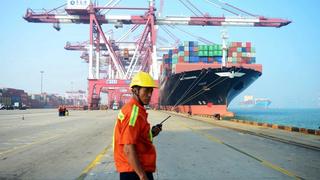
Australian interests
In 2020, Australia became China’s newest target. Following the Australian Government’s call for an independent international inquiry into the origins of COVID-19 in April, China applied an 80 per cent anti-dumping duty to barley exports, effectively ending the trade. In subsequent months more trade bans were applied, utilising both formal (anti-dumping) and informal (customs procedures) methods. By year-end, China had restricted the import of 13 different products and services from Australia.195 The affected industries exported $54 billion to China in 2019,196 a serious economic blow coming atop the dislocations of COVID.
However, Australia stands out for its defiance of Chinese trade sanctions. The Australian Government has refused to offer any mea culpa, and in December 2020 referred Chinese tariffs on barley to the WTO dispute settlement mechanism. The dispute will be heard as case “DS598” in 2021.197 Flagging a departure from the Trump era, incoming US National Security Advisor-designate, Jake Sullivan, indicated the Biden administration will “stand shoulder to shoulder” with Australia in the dispute.198 DS598 will prove a landmark test of China’s ability to use trade sanctions as a means of diplomatic coercion, as an Australian victory will enable retaliation through the WTO. Importantly, it also multilateralises a matter previously handled bilaterally, allowing Australia to pool resources with like-minded countries.
Coordination between Australia and the United States would greatly aid efforts to deter, and defend against, Chinese economic coercion. Due to size differentials, middle powers such as Australia, Canada and Korea cannot effectively respond to Chinese trade sanctions alone. Collective responses provide the best defence against economic coercion. US involvement will be critical to collective defence strategies. Its economic size — and thus scope for retaliation — is a powerful deterrent to further Chinese action. US support for such efforts will also provide reassurance to allies and partners when contesting Chinese foreign policy.
Policy recommendations
- The United States should coordinate with and provide third-party support to Australia’s WTO dispute with China. Australia is the first country to challenge Chinese trade coercion at the WTO. But as an infrequent WTO litigator,199 Australia’s case would benefit from US support. This could include preparatory discussions between the Department of Foreign Affairs and Trade (DFAT) and the Office of the US Trade Representative as well as the United States directly participating in the DS598 process as a third party.
- The United States should review policies obstructing the normal functioning of the WTO Dispute Settlement Mechanism (DSM). Due to US appointment vetoes, the WTO Appellate Body is presently inquorate.200 China may strategically use an appeal to the Appellate Body to indefinitely delay a resolution to DS598. Restoring normal function to the DSM by removing US appointment vetoes, and then promptly clearing an existing case backlog, will be essential to ensure a timely and successful resolution.
- The United States and Australia should explore beyond-the-WTO “collective defence” mechanisms with like-minded partners. A collective defence mechanism that responds more promptly than the WTO is needed to deter Chinese economic coercion. Some type of “economic article five” mechanism involving the United States and its allies — similar but not identical to the collective defence provisions of NATO — will be the most effective means to do so. Australia and the United States should immediately consult with partners on the potential options with a view to establishing practical mechanisms in the medium term.
Avoid protectionism to maximise joint economic opportunities
Dr Stephen Kirchner
Context and background
Australia needs to work with the United States to ensure that Australia’s domestic policy objectives in areas such as manufacturing capability, supply chain security and digital platform regulation maximise joint economic opportunities and promote tax and investment certainty on a bilateral and multilateral basis. Australia should work within the context of existing and prospective trade agreements and multilateral negotiations to secure non-discriminatory approaches to these issues that reinforce the joint interest in a rules-based multilateral trading system.
The US and Australian governments have both announced efforts to examine manufacturing capability, the security of supply chains and critical goods. These efforts are potentially complementary and afford trading opportunities for Australia as a trusted ally and supplier. However, these efforts need to be harmonised to minimise the potential for unilateral and discriminatory approaches that could undermine the bilateral economic relationship and the international trading system.
Similarly, the Australian Government’s taxation and regulation of digital platforms should leverage multilateral negotiations in this space that avoid discriminatory treatment of foreign commercial interests in pursuing domestic policy objectives. The content deals between Australian media and US tech companies defused a potential irritant in the bilateral relationship. The focus of digital platform regulation should be minimising international tax and investment uncertainty. This is more likely to be achieved by working through multilateral mechanisms and extending the digital commerce provisions of existing and prospective bilateral and plurilateral trade agreements.
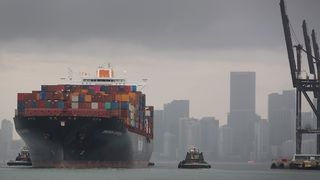
The Biden administration
Trade will not be an urgent priority for the administration relative to domestic issues. An early indication will be whether it seeks renewal of Trade Promotion Authority (TPA) from Congress when the current authority expires at the end of June 2021. If TPA is not sought or granted, trade negotiations will be downgraded in the administration’s first term.
There is growing public support for foreign trade in the United States and a partisan realignment around trade and tariffs as a result of Trump’s failed embrace of protectionism. However, the Democratic Congress is still sceptical of free trade and trade agreements and is well disposed to industry policy with a view to furthering domestic employment and economic recovery objectives.
These protectionist instincts have received a boost from concerns about national security and supply-chain resilience in the wake of the pandemic. Biden’s pre-election trade policy consisted of a commitment to the onshoring of production of critical and strategic goods — currently the subject of a review. These concerns could become a fig-leaf for more traditional forms of protectionism.
Figure 12. American’s views of what foreign trade means for the United States
What do you think foreign trade means for America?
Do you see foreign trade more as an opportunity for economic growth through increased US exports or a threat to the economy from foreign imports?
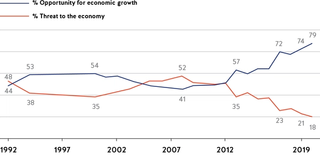
The Biden administration is reviewing Trump’s tariffs, including the steel and aluminium tariffs from which Australia secured an exemption. The ‘phase one’ trade deal with China is also under review. The purchasing commitments made by China under the deal may have been a factor in the imposition of Chinese anti-dumping duties on Australian barley.201
Katherine Tai, President Biden’s nominee for US Trade Representative, has indicated that climate change will be a centrepiece of the administration’s trade policies in support of the goal of net-zero emissions by 2050.
While the US Government has domestic anti-trust concerns about ‘big tech,’ the US Trade Representative can still be expected to champion the interests of US multinational corporations abroad where foreign governments enact measures that discriminate against US commercial and national interests.
Australian interests
There may be opportunities for Australia to capitalise on national security and supply chain concerns as a trusted ally and supplier in expanding the bilateral trade and investment relationship. There is already cooperation between Australia and the United States in relation to critical minerals202 and the defence industrial base. But an inwardly focused and protectionist US trade and industry policy has the potential to discriminate against Australian commercial interests directly, as well as weigh on global trade. The Australian Government needs to highlight the economic opportunity in joint approaches that expand rather than limit trade.
An inwardly focused and protectionist US trade and industry policy has the potential to discriminate against Australian commercial interests directly, as well as weigh on global trade. The Australian Government needs to highlight the economic opportunity in joint approaches that expand rather than limit trade.
The US efforts to address climate change at an international level, alongside those of the European Union, are likely to weigh on carbon-intensive exports, including those from Australia, such as thermal coal.
The Australian Government’s proposed regulation and taxation of digital platforms attracted attention from the US Trade Representative under the Trump administration, who noted concerns about due process and investor protection under the Australia-US Free Trade Agreement,203 although competition policy is an explicit carve-out from the dispute resolution provisions of the agreement. The content deals between Australian media and US tech firms have provided a temporary fix. However, the issue underscores the importance of ensuring that domestic regulation is consistent with the principles of non-discrimination and serves to promote international tax and investment certainty.
Policy recommendations
- Australia should work with the United States to ensure that they harmonise efforts to promote manufacturing capability and the security of supply chains and critical goods. This will maximise the joint economic opportunities available from these efforts and avoid unilateral measures that may undermine rather than reinforce the bilateral economic relationship.
- The Australian Government should seek to extend the digital commerce provisions of existing and prospective trade agreements and multilateral solutions to the regulation and taxation of digital platforms that promote international tax and investment certainty.
Build cyber capability and cooperation for an evolving threat landscape
Dr Jennifer S. Hunt
Context and background
To deepen cooperation on cyber issues, Australia should restore critical bilateral and multilateral cyber efforts while also recognising that cyber-enabled disinformation is part of the expanding cyber threat landscape.
Australians and Americans consistently rank cyber attacks in the top five of global threats.204 It is easy to see why. Recent cyberattacks in the United States have targeted critical infrastructure including government agencies, hospitals and utilities. In February 2021, a water treatment plant in Florida was hacked through remote access and the sodium hydroxide mix remotely changed to dangerous levels before being caught and reversed in real-time by the plant operator.205 In 2020, at least two foreign governments breached the US Department of Homeland Security and Treasury and exposed Fortune 500 companies in what was described by some as the “Cyber Pearl Harbor” by inserting malicious code into a popular software product.206
Cyber is the connective tissue through critical state, economic, social and strategic systems. Increasingly the soft underbelly, however, is democratic infrastructure. As state conflicts expand to cyberspace, cyberattacks now target not just information systems, but electoral systems and even voters themselves through cyber-enabled disinformation campaigns.207 Cyber scholar Herb Lin notes the difficulties of defence — while traditional cybersecurity threats exploit the vulnerabilities of the system, these evolving attacks exploit its virtues, as cyber-enabled disinformation harnesses the openness and virality of social media to spread disinformation and conspiracy theories to poison democratic function.208 Whether for great power competition, private profit or pure entertainment, these tactics represent an evolving strategic challenge to democracies and Australia is not immune.209 The COVID-19 pandemic in particular has only heightened these challenges. In March 2020, the Australian Cyber Security Centre issued an alert warning of malicious websites masquerading as trustworthy authorities on coronavirus information, disinformation that could have undermined state responses to the pandemic.210
Australia invested significantly in cyber capacity and coordination under the Turnbull government including the introduction of a Special Advisor on Cyber Affairs (within the Department of Prime Minister and Cabinet), a Cyber Ambassador (within the Department of Foreign Affairs and Trade) and the Australian Cyber Security Centre (within the Australian Signals Directorate). Under the Morrison government, cyber policymaking has shifted to Home Affairs, the cyber diplomatic portfolio has expanded to include critical technologies and Australian Cyber Security operations in the Australian Signals Directorate have been given a significant boost in funding. Alongside the government’s 2020 Cyber Security Strategy, Canberra announced A$1.35 billion over 10 years, in part for training and recruiting more than 500 cyber specialists.211 These domestic efforts have been paired with significant engagement on the international front, but some bilateral efforts were abandoned under the Trump administration.

The Biden administration
Individual US states have focused on bolstering their cyber defences but the federal government and the United States more broadly have lost valuable time in countering the newest evolution of attacks due to the Trump administration’s neglect of cyber issues. This neglect included: the dismissal of the Cybersecurity Coordinator position at the White House, the shrinking of the State Department’s cyber diplomacy wing, and repeatedly ignored calls for bolstering electoral security. President Trump publicly sided with Vladimir Putin over US intelligence agencies’ assessment of hostile foreign interference in cyber and electoral matters.212 In one of his last acts in office, President Trump dismissed the director of the Cybersecurity and Infrastructure Security Agency at the Department of Homeland Security after the official confirmed Joe Biden’s win in the 2020 election.213
The Biden administration must rebuild an atrophied state and fortify industrial capacity to counter diverse attacks. President Biden has signalled the prioritisation of cyber issues with a proposed US$10 billion funding package and the appointment of cybersecurity officials in key leadership positions across multiple departments. Cybersecurity officials occupy five positions on the president’s National Security Council, with others in senior posts across the Department of Justice, Treasury, State and Homeland Security. This allows for crossover and prioritisation of cyber in diverse portfolios. Overseeing coordination is the National Cyber Director, a position newly created by the 2021 Defense Authorization Act to improve US cyber defences through resilient networks, bolster offensive operations to impose costs on adversaries and coordinate with industry, the academy and close allies.214
To reflect the evolving national security challenges in cyberspace, President Biden’s appointments also include disinformation and counterterrorism experts. Cyber increasingly sits at the nexus of growing domestic extremist activity, with online conspiracy theories about emails, servers and laptops leading to offline physical violence. In 2019, the FBI warned against “conspiracy-driven domestic terrorism” naming QAnon and conspiracies like Pizzagate.215 When Facebook216 finally shut down QAnon group pages in 2020, they found the fastest online conspiracy group comprised one million members across 15 countries including Australia.217 National security expert Peter Singer argues that the weaponisation of social media and the promulgation of extremist groups on Facebook has exacerbated challenges in nearly every policy area, from aiding terrorist recruitment to being a state tool of great-power competition to damaging the vitality of democracy.218
The Biden cyber team
The Biden administration used its first month to signal the prioritisation of cyber issues on the national agenda through the appointment of officials with cyber experience across multiple departments.
- Biden’s National Security Council includes five experienced cybersecurity officials including:
- Anne Neuberger as Deputy National Security Advisor for Cyber and Emerging Technology, a new position designed to elevate the subject internally
- Senior Director for Cyber, Michael Sulmeyer
- Homeland Security Advisor Elizabeth Sherwood-Randall, her deputy, Russ Travers as Deputy Homeland Security Advisor and Caitlin Durkovich as Senior Director for Resilience and Response at the National Security Council.
- In the White House’s Office of Management and Administration, David Recordon will become Director of Technology.
- The Deputy Attorney General nominee, Lisa Monoca, also comes with cybersecurity portfolio experience.
Australian interests
Australia’s interests in the cyber realm similarly lie at the intersection of technical and disinformation challenges. ASIO has warned that far-right extremists are exploiting COVID-19 disinformation to recruit and radicalise Australians online.219 While cyberattacks are generally measured in dollars, disinformation is measured in lives.220 In 2020, separate reports by the European Commission221 and the US State Department222 found that foreign actors, led by Beijing, Moscow and Tehran had carried out targeted online disinformation campaigns aimed at stoking confusion about the COVID-19 pandemic. Australia’s distance does not provide immunity to either a global pandemic or cyber-enabled disinformation as evidenced by Australian lockdown protestors shouting “Arrest Bill Gates” and attacking 5G infrastructure.223
Policy recommendations
Beyond recognising cyber-enabled disinformation as a part of the cyber threat landscape to build both defensive capacity and social cybersecurity resilience, Australia and the United States should also:
- Resume the Cyber Security Track 1.5 Dialogue224 in the 2021 Australia-US Ministerial Consultation225 inclusive of Australia’s inaugural Ambassador for Cyber Affairs and Critical Technologies. These talks should be inclusive of Australia’s Ambassador for Cyber and Critical Technologies, Dr Tobias Feakin. Australia’s cyber ambassador has been in close contact with America’s allies during Washington’s relative hiatus from multilateral cooperation and can provide insight from extensive engagement on cyber issues with partner nations and the United Nations.226
- Coordinate with NATO’s efforts on collective defences to emerging cyber threats227 including cyber disinformation operations and electoral interference. The cyber realm is included in President Biden’s emphasis on building resilience in democracies. While working to deepen cyber cooperation between Five Eyes partners, Australia should also continue to engage closely with multilateral efforts alongside the United States at the United Nations and NATO to strengthen cyber norms and build collective responses to diverse cyberattacks that threaten state institutions, industry and democratic function. This includes recognising cyber-enabled disinformation as a threat alongside breaches and hacks and building defensive social cybersecurity accordingly.228 As countries like Finland229 have demonstrated, resilience against cyber-enabled disinformation campaigns does not merely require a technical or engineering solution. Often, the best solutions can be found in the social sciences230 and humanities.231 Research and educational links such as international visiting fellowships,232 scholarships and targeted grants can be used to efficiently explore the adaptation of allied efforts to counter disinformation to the Australian context.





